#and then you have barbie the character in the general cultural imagination of…anyone who knows what barbie is
Text
barbie isn’t a feminist or misogynistic she’s a plastic toy
#i know this sounds like im being a hater but imagine me saying this as genuinely and earnestly as possible#cause like ok. you have Barbie™️ the product produced by Mattel and marketed AS empowering#and then you have barbie the character in the general cultural imagination of…anyone who knows what barbie is#and opinions on THAT range from Misogynistic Consumerist Insecurity-Creating Stereotype#to Girlboss Empowering Femininity Do-Anything-Be-Anything Feminist#and this feels obnoxious to say because I thought the movie was mid but they did like. very briefly conceptualize this as like#barbie is a construct barbie isn’t real and as such barbie is whatever exists in the minds of really kids but also i suppose#other barbie enthusiasts hahah. and because of that barbie becomes a figurehead for womens leadership and strength OR a reenactment#of patriarchal norms (kids very much will take barbie’s scrubs off and marry her to ken and have her be a housewife lol this is a Thing)#or or or barbie is a vehicle for discovering lesbianism. or playing imaginary torture.#so like in the most detached I Don’t Even Care About Barbie I’m Just Postin Here way possible. Barbie is a plastic toy.#everyone ignore this im just talking on my silly little blog#old man yells at cloud
5 notes
·
View notes
Text
This... Is BGNN
Things you might want to know, for Mar 29, 2023:

House of the Dragon Season 2 Will Be 2 Episodes Shorter Than Season 1 — Hm. In the context of cost-cutting and write-offs at Warner Brothers, this is kind of alarming. GoT was arguably drawn out more than it should have been, but HotD has rocketed through years of history already… I’m not sure anyone but the bean-counters benefit from an increased pace.
Reddit cracked down on revenge porn, creepshots with twofold spike in permabans
This Uncensored Chatbot Shows What Happens When AI Is Programmed To Disregard Human Decency — I feel like we need to stop calling these things “chatbots”. This stuff is to human conversation what Google was to Yahoo’s search index… a bigger, faster, friendlier way to search the exact same content-swamp. The only new thing here is that unlike every other search tool ever built, these things don’t automatically cite their sources —something Bing is working on, to their credit— and make it clear that you’re simply looking at a smartly arranged regurgitation of the unbridled web.
Man in Alabama steps out of car to watch cracks forming on ground — then bridge collapses (video)
The fantasy of Ted Lasso and the reality of Jason Sudeikis — GASP! Are you saying —hold on, I need a second to recover from the thought— that actors are not the characters they portray?!?!

Stop Using Celebrities to Talk About Age Gap Relationships — This is actually one of the more useful pieces I’ve seen on the subject in some time. There is a world of difference between Bradley Cooper and your weird uncle who hits on your friends when you bring them home for Thanksgiving… the former exists in a permanent state of constrained supply and unlimited demand, while the latter is desperate for any young ass he sees and still has candied yam stains on his shirt.
Disney Lays Off Ike Perlmutter, Chairman of Marvel Entertainment — About fucking time. That Trump-loving cretin is directly responsible for the semi-failure of ABC’s Agents of SHIELD and Inhumans, not to mention the lack of growth and innovation at Ye Olde Marvel Comics over the last twenty years. (Turns out trying to engineer a corporate coup at Disney was the line he couldn’t cross.) Good goddamned riddance, Ike.
Ex-Sims Dev Says Men Lie About How They Play Game Out Of Embarrassment — When I was a little boy watching Saturday morning cartoons, I would get uncomfortable and avert my eyes whenever Barbie or other “girly” ads appeared. Now imagine an entire generation of boys, twenty years younger, who never grew out of that…
Narcan is now FDA approved for over-the-counter distribution. Here's how to use it.
Remembering Euell Gibbons' Grape Nuts commercials — Those spots are certainly memorable to those of us Of A Certain Age, but I’m pretty sure almost none of us ever consumed the food they were trying to sell. Grape Nuts were nasty.
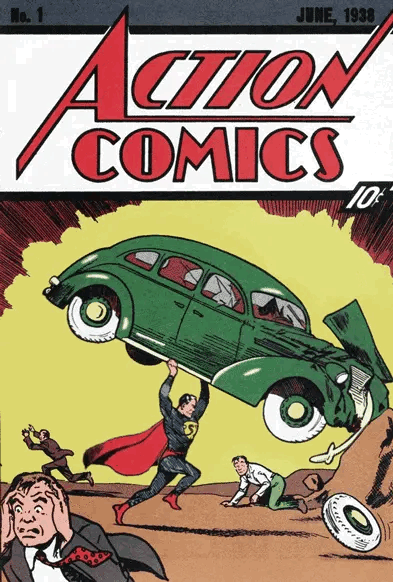
How Two Jewish Kids in 1930s Cleveland Altered the Course of American Pop Culture — I’ve read this story 100 times since I was a kid, and I never get tired of it.
How to test what an AI model can — and shouldn’t — do
Is TikTok Actually Creating More One-Hit Wonders? — I think the internet in general is doing that, not TikTok in particular.
Marvel at Penn & Teller's unique take on ye olde donut-on-the-ribbon magic trick (video)
How to End Bias and Taboos in Women’s Health Care — An important discussion to be had… I’ve had an up-close-and-personal look at how ill-equipped the medical profession can be when faced with women whose symptoms and consequences don’t track with the default male “norms”.
undefined
youtube
Asteroid City’s first trailer is the most Wes Anderson thing you’ll see today — Wes is a genius, whose work never ceases to delight even as it occasionally perplexes. And he infuses everything he touches with his aesthetic… unlike a Tarantino film, which always looks like whatever movie or genre Quentin is referencing at the time, all of Anderson’s movies look like Wes Anderson movies.
How Good Smile, a Major Toy Company, Kept 4chan Online
6 notes
·
View notes
Text
Paris Haute Couture Week S/S 2020 Plus a Little Jacquemus: Okay, Dior DID Suck (Part 2/2)
Hi to anyone reading,
First of all, thank you! I have never had a post do as well as the part 1 of my haute couture week review did and I am so overwhelmed with the positive feedback. This is probably funny to read for those of you getting thousands of reblogs on your posts, me acting like I won an academy award because I got a couple of hundred, but honestly I don’t expect any traction when I write on here (it’s basically just me word vomiting everything I’m thinking as if people want to hear it aka. mouthing off into what I thought was the void) so if you did read it, thank you! I do spend a long-ass time on these so it means a lot:-)
I’ll leave the self-indulgent ramble there though as it’s probably not what you came for and jump straight into part 2 of my thoughts, starting with Jacquemus. Yeah, I knew what I was doing when I tagged that in my last post. Simon Porte Jacquemus is the man of the *fashion* people right now; I’ve even found myself coming round to the Le Chiquito bag despite my original thought being “well, that’s fucking useless”. I know, I know, technically it’s not haute couture; it was part of Men’s Fashion Week, but it happened around the same time and everyone was talking about it on Twitter, so I feel like I have to include it.
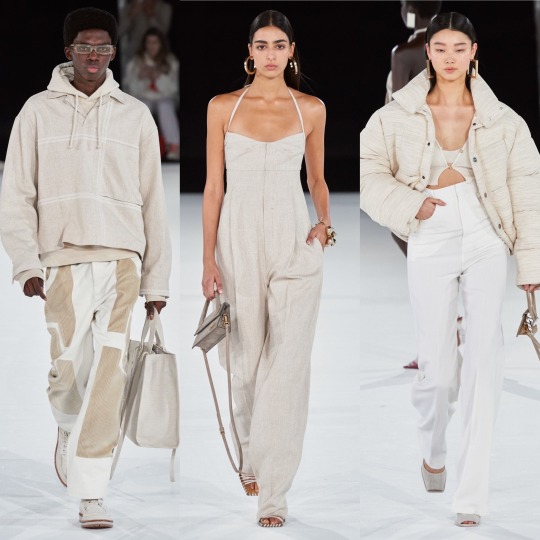
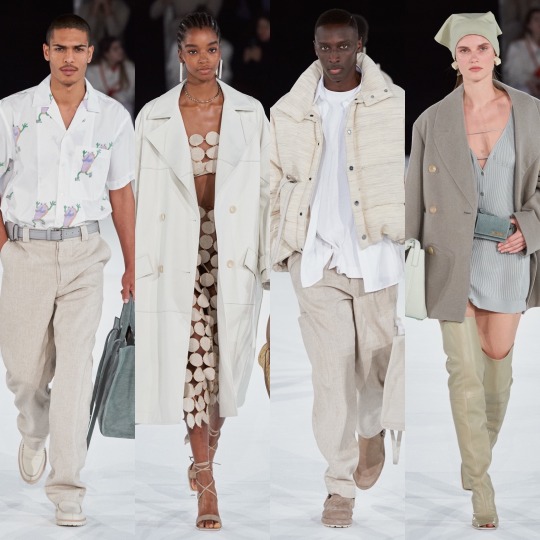

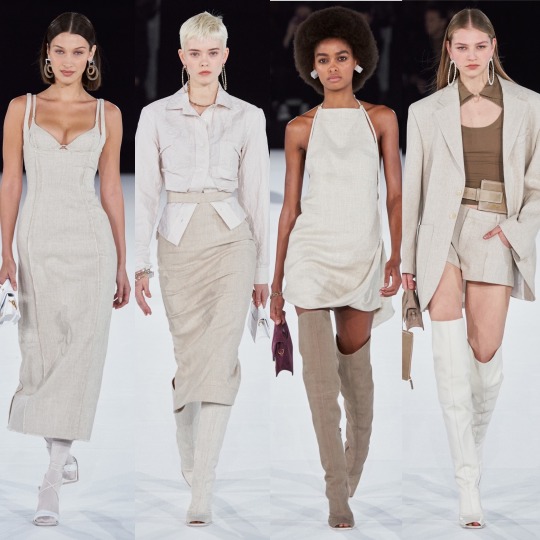



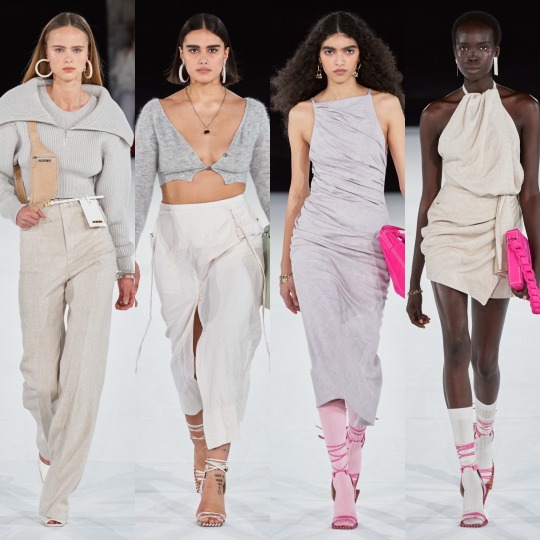

In a way, it kind of reminds me of Bottega Veneta’s last RTW show, in that, especially with the women’s outfits, we seem to be sticking with simple, fitted garments and chunky, more statement jewellery. I’ve got to say I like the styling here a lot more though, and in general I’m a fan of this collection. The collared tops with cut outs underneath blazers are cool and I can’t wait until it gets warm enough for me to not feel dumb wearing my headscarfs like this; there’s a LOT of summer outfit inspiration. It’s not a mind-blowing collection or anything but it is effortlessly sexy and that’s something I wish I could say about myself. Most of us can only hope to look half as good as these models do whilst making the effort but at least Jacquemus is aspirational, lol.
I also fucking adore this colour palette. I’m sick of neutrals literally just meaning brown and white; the navy, sand and muted khaki is a fresh edition to what is usually interpreted as the colours you’d seen worn by Disney’s Riverboat Cruise staff and only Disney’s Riverboat Cruise staff. And I mean, come on-what is more neutral than typical English school carpet blue.
Next for the whole reason I had to make this haute couture week review 2 separate posts: Jean Paul Gaultier’s final show.
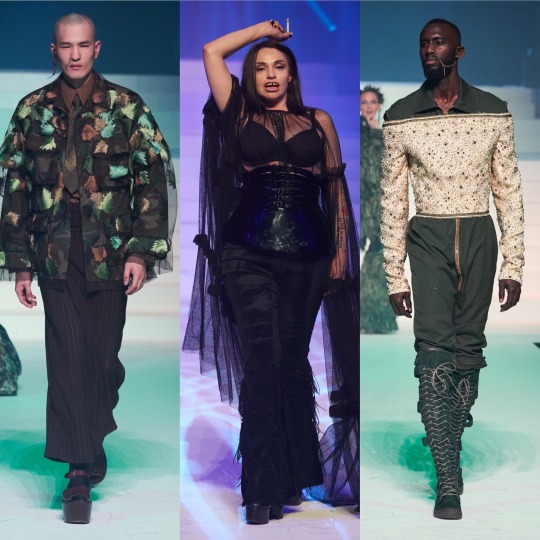



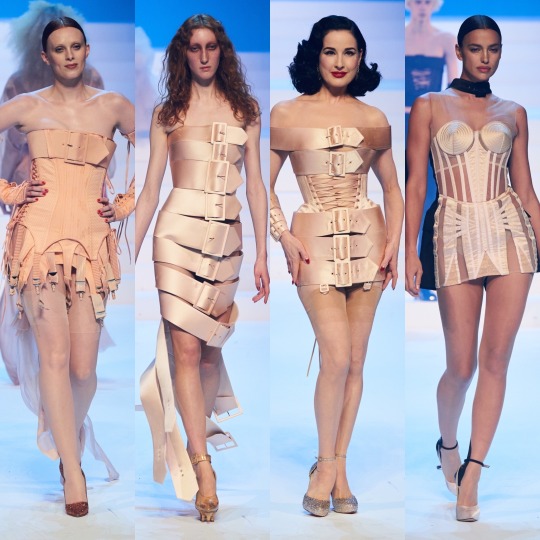





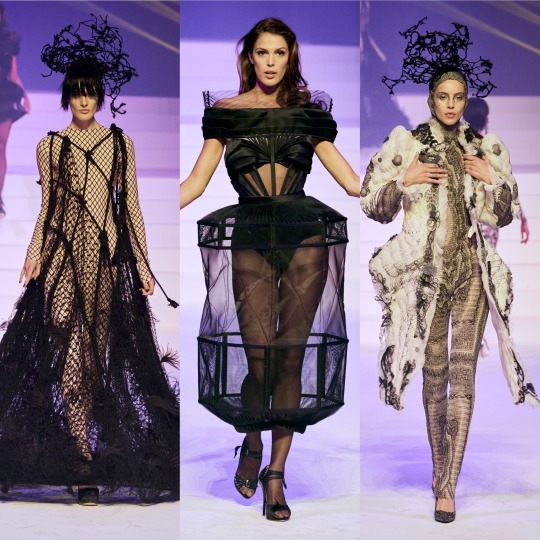
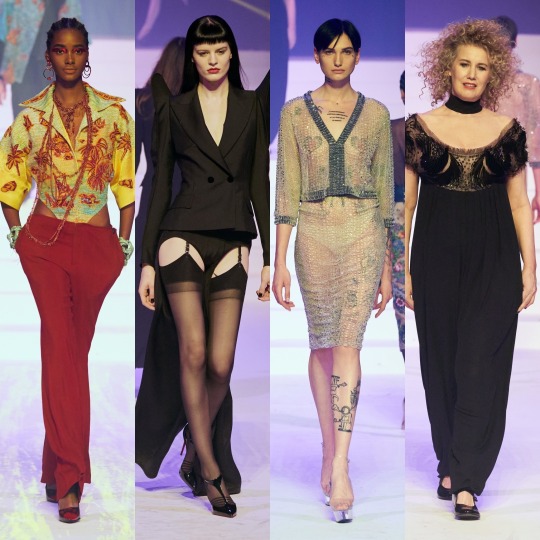


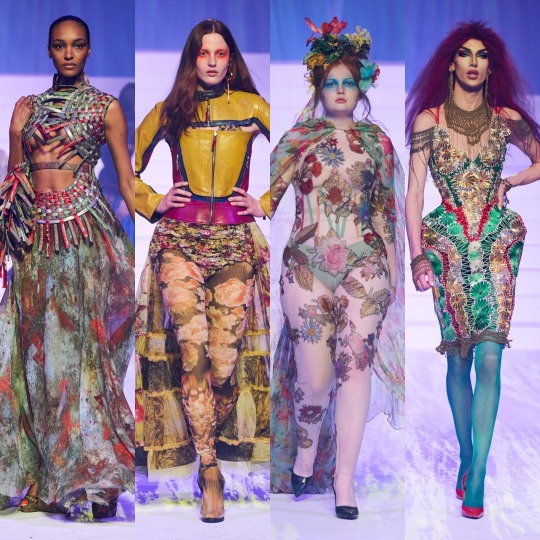








In the best way possible, it’s a lot. I don’t even really know where to start, except to say that I guess this is a fitting last show; a celebration of everything campy, messy, weird, performative, and punk is the perfect send off for a brand whose best known perfume of the last few years is called Scandal. More than anything, the final show represented the range of characters and cultures that have influenced JPG throughout his half-a-decade-long career, the lines that supposedly separate what is “masculine” and “feminine”, “old” and “young” and ultimately art and fashion blurred in the most exaggerated way possible. Sure, there are some looks which are individually a bit messy here but the way they were grouped into almost chapter-like segments meant that when you see them all together, they work. Nods to the patterns and structures that recurred from season to season were sprinkled throughout, from sailor stripes to corsets to the expected whirlwinds of colour. I’ll even allow the wellies in that one outfit; if I can get over bucket hats in Peter fucking Pilotto’s last RTW show, I can get over some questionable shoes here. Middle aged fishermen and boys who liked to pose with monster carp in their Tinder pictures as some weird display of masculinity everywhere rejoice.
Now onto a show that I personally found slightly disappointing: Margiela.

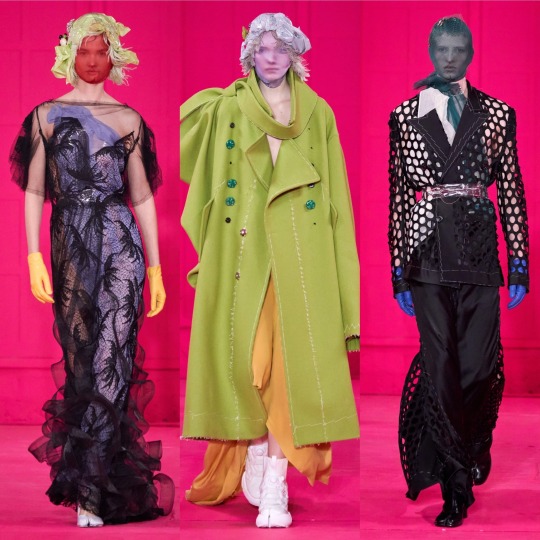
I think this one is a bit TOO weird for me. Like if you’re gonna go avant-garde, go all out. Chiffon gimp masks (I don’t know if that’s the intention here but that’s what I’m getting, sorry Maison) are something I’m not particularly fond of and I’ve never been a fan of the Tabi boots in the first place, let alone when they’ve seemingly been blown up to Michelin man style proportions. I didn’t find the show to be a total lost cause-I enjoyed the colour palette and I’ve always liked that contrast stitching detail, plus the bowler hats are interesting-but on the whole considering how much I liked the last RTW show, this is a bit of a let down.
The looks I included are salvageable but (I feel mean saying this) there were genuinely a lot of pieces that did just resemble bits of fabric draped over each over with no discernible rhyme or reason, so much so that they reminded me of some of the monstrosities I saw at a Drag Race pub quiz this one time where we had 5 mins to make some garms out of loo roll and then have a team member model them for points down a makeshift runway.
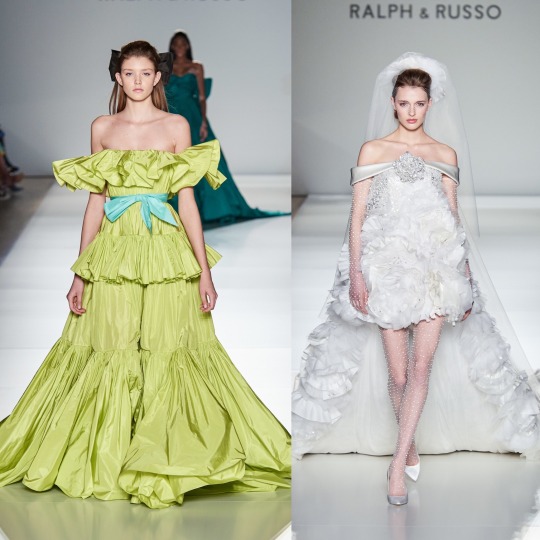
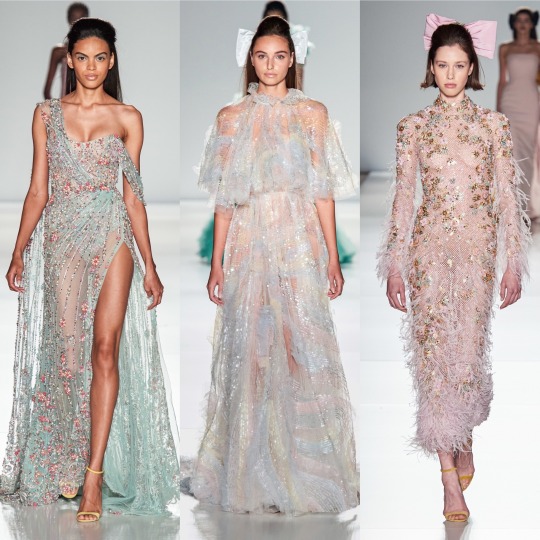
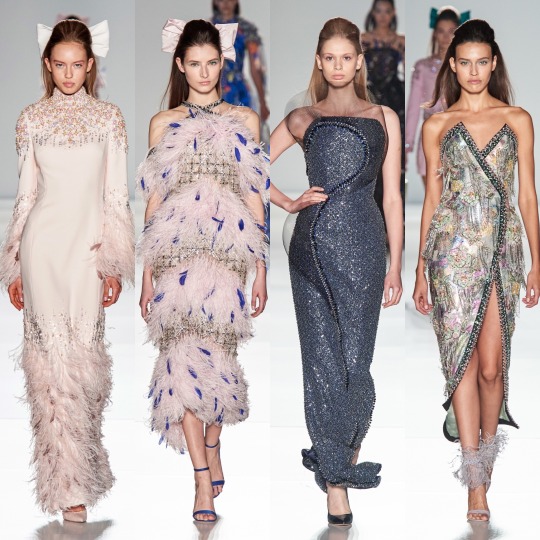
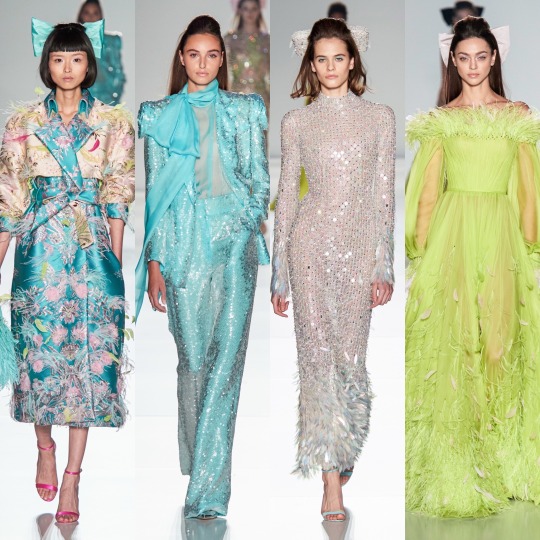
Ralph and Russo was alright. There were a few pieces that I really liked but again, I can’t help but compare this collection to the last, where it felt like the fussy details of bows and sequins and feathers and the Barbie Dreamhouse palette were utilised with a direction in mind. Here, I don’t get that. As ever, the gowns are gorgeous and I’d pay good money just to try one on for five minutes but as an overall collection I’d say there was a lack of higher vision, which is probably the snobbiest sentence I’ve ever written so forgive me.
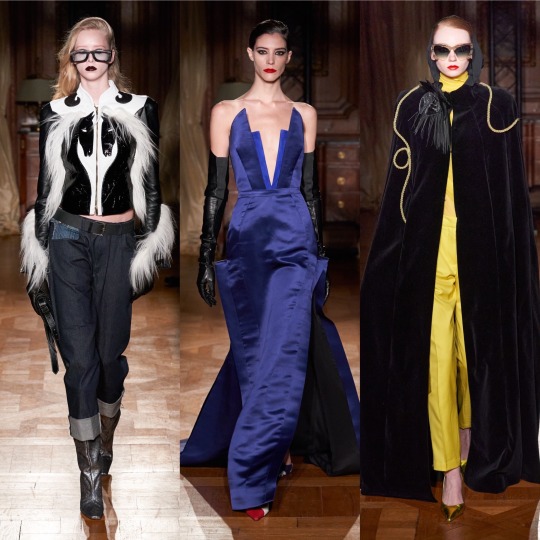
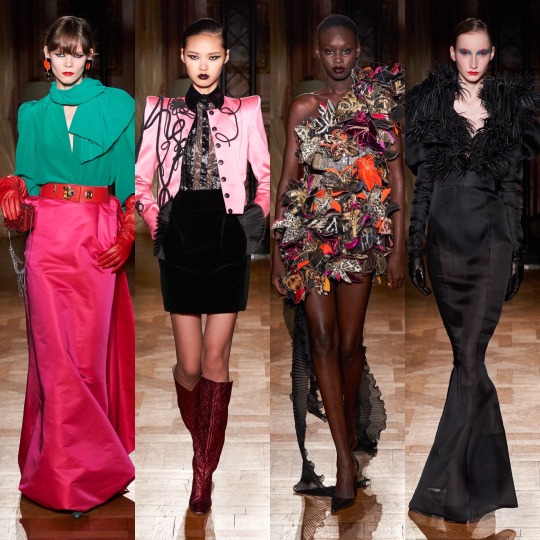
As for Ronald Van Der Kemp, I could’ve done without including it to be honest, if it weren’t for the few pieces I’m in love with: the velvet cape, fur trimmed jacket and blue satin dress are probably my favourite pieces here.
So onto a collection I liked a lot more: Schiaparelli.
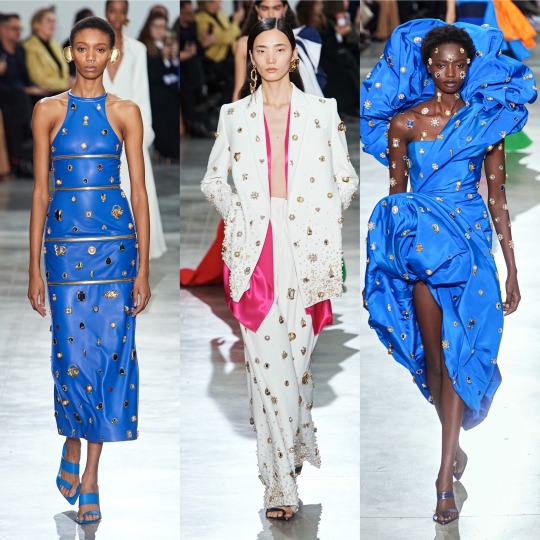
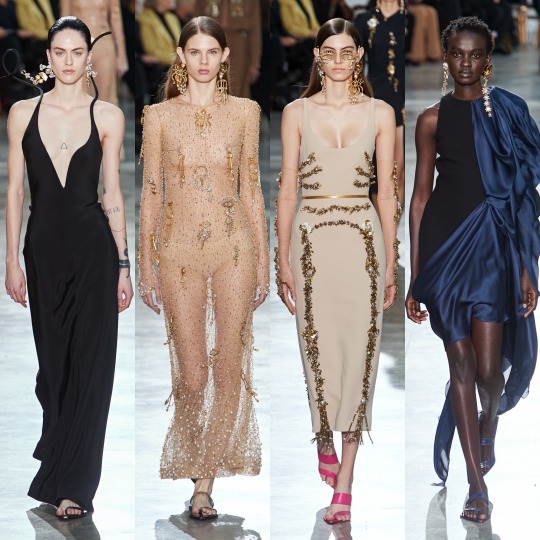



The influence of nature from flowers in bloom to insects to the organic structure of the human skeleton is as present as ever, though this collection includes a lot more delicate symbolism than usual. Honestly, the details make it for me; the brooches, earrings and facial jewellery are other-worldly touches to outfits that could otherwise be simple fashion magazine editor on-the-go. That’s not in itself a bad thing! The suits are gorgeous. I mean, I’m talking fashion editor in New York in a power suit yelling orders down the phone while she rushes along with a coffee. A Miranda Priestley in the making type woman. THAT’S a modern take on the divine feminine that Maria Grazia should’ve been going for; our goddesses aren’t women who sit around looking pretty (though that helps too) and place curses on mere mortals anymore, they’re women who get shit done.
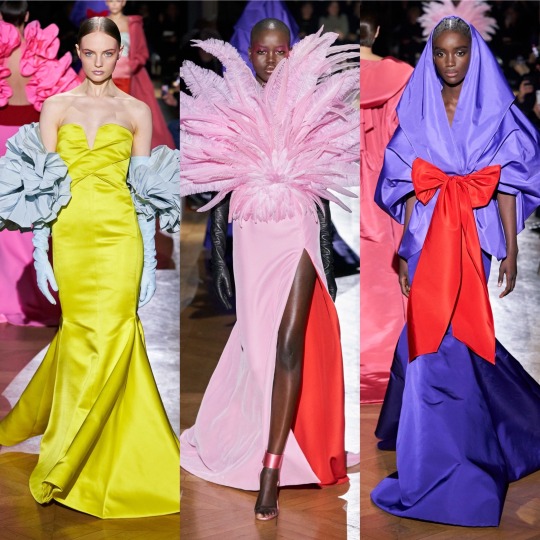





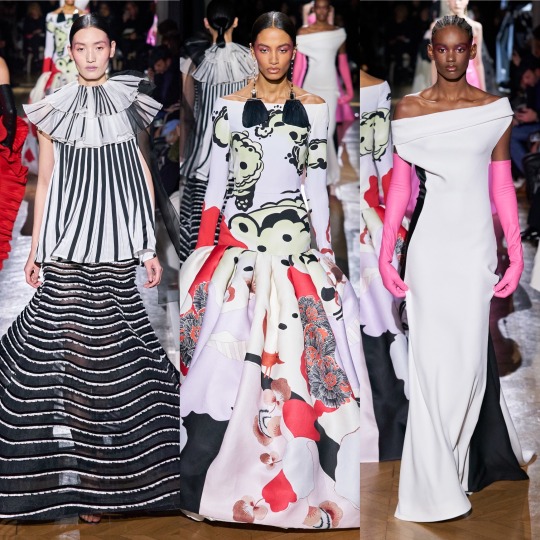

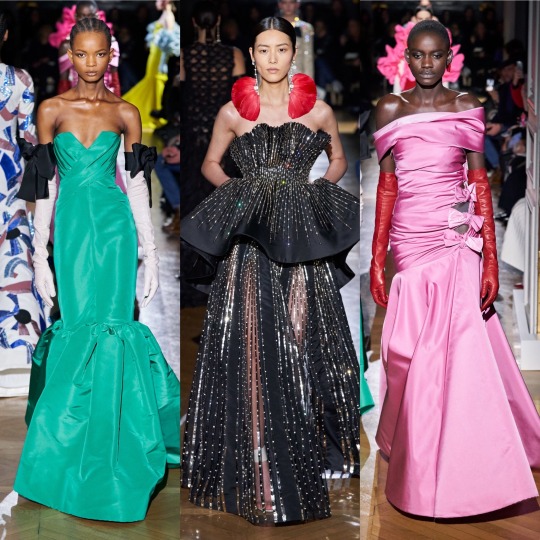

With regards to Valentino, which was also a delight, let me start by saying this colour palette is EVERYTHING. It’s ugly sisters in Cinderella fantastic, and we know those 2 were the real fashion icons really. Other than that, I adore the Old Hollywood silhouettes from the gloves to the Liz Taylor-in-Cleopatra-level-dramatic earrings. Everything is opulent and expensive-looking and pretty much what we’ve all come to expect from Valentino. A strong 8/10.
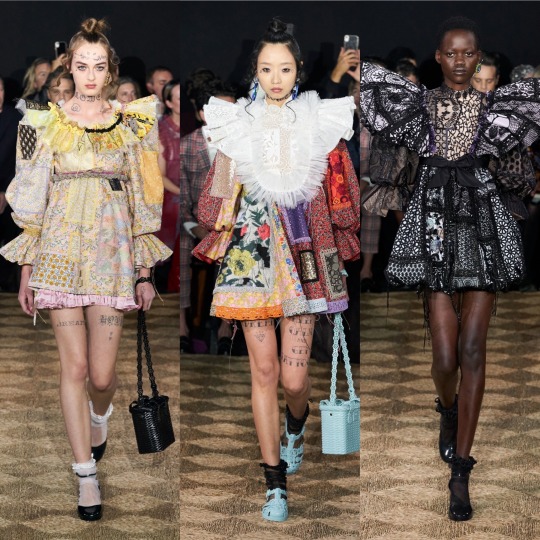

For me personally, Viktor and Rolf was a standout and one of my favourite collections of haute couture week. It’s not going to be everyone’s cup of tea and I know it’s at the complete opposite end of the spectrum to what was probably my other favourite collection, Elie Saab, but this is just my style down to a T, the perfect balance of grungy and cutesy that I want to achieve.
There’s probably going to be a lot of objections to the temporary face tattoos and I get that, but I think they’re fucking sick. I obviously wouldn’t get a permanent one lest my mother murder me in cold blood however if I did, you bet I would be pairing them with frilly-ass babydoll dresses that you could pick up in Camden Market like this.
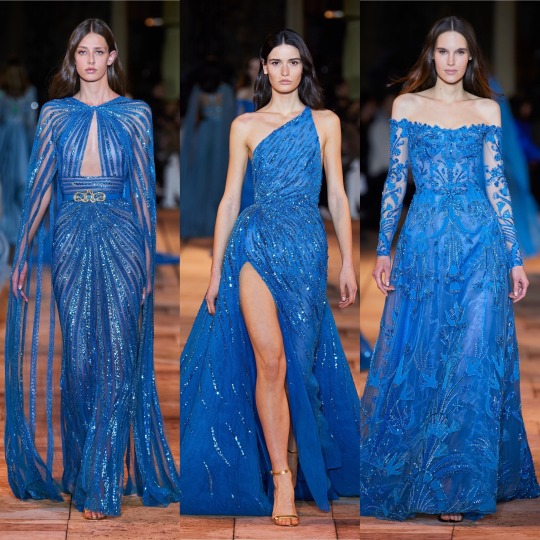
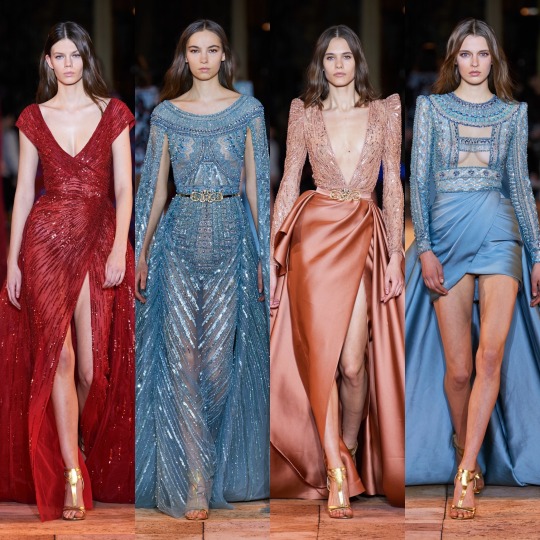


And last but not least (that would be Dior), there’s Zuhair Murad.
Sigh.
IDK, man. Seeing Zuhair Murad dresses on Tumblr and WeHeartIt (remember that site? It still exists!) as a 14 year old was one of the things that got me into fashion, so it sucks that almost every time a new collection comes around, I feel underwhelmed. Disappointingly, the brand hasn’t really progressed all that much since 2013. It goes without saying that the stoning and the embroidery and sequins are stunning and would make anyone feel like a princess but from a critical point of view, I’m just not seeing anything new here. Whereas I feel like Elie Saab, for example, reflected the growing fascination with East Asian fashion and recognition of the supremacy of the region’s street style in his haute couture last collection, Zuhair Murad seems to be stuck designing the same dresses he was 6 years ago.
To pick one example, the rounded stoned necklines are so outdated that they’ve been making their way onto department store prom dresses for years. I get that it’s supposed to be a reference to Ancient Egyptian style and I respect that, I was one of those 8 year old that was obsessed with mummies and the “Curse of Tutankhamun”, but couldn’t it be done in a more interesting way? It’s Maria Grazia’s spin on Ancient Greece all over again. Now I get how how the I imagine very niche subsection of people who are into fashion and Julius Caesar (okay, so I don’t even know if they still believed in mythology and all that malarky at that point in history but just roll with my comparison here) might’ve felt going through Vogue Runway. Anyway, I hate to end on a critical note and so be clear, these are still absolutely magnificent dresses. If we ignore those ugly round necklines, that is.
So that’s it for this post! If you read part 1 and 2, I hope you enjoyed it! As always, let me know your opinions and feel free to disagree. I’m literally just about to start trawling through all the A/W 2020 RTW collections though I imagine that’s gonna take me way longer to do than this, so I wouldn’t expect that for a month or two. In the meantime, I’m trying to fit shooting a Euphoria-inspired lookbook into my days off work which is looking atm like it’s going to be the end of March, so look out for that, and also a review of the red carpet fashion from this season’s award shows.
As ever, thank you so much for reading and again, thank you for the reception on part 1 if you were one of the people that read it. It makes staying up til 3am with the jitters seem worthwhile, lol!
Lauren x
#haute couture#haute couture week#pfw#pfw2020#paris#fashion#fashion week#designer#jacquemus#style#review#dior#sequins#pretty#aesthetic#zuhair murad#grunge#viktor and rolf#valentino#luxury#schiaparelli#georges hobeika#maison margiela#margiela tabi#jean paul gaultier#jpg#jpgaultier
137 notes
·
View notes
Text
Quarantine Movie-Watching Journal, Continued
Throughout all this quarantine time I’ve been chronicling my watching movies, I’ve also been reading books, but have had assorted troubles on a level that seems close to basic comprehension, or just getting on their wavelength. Part of this is having a certain tendency towards the difficult or avant-garde in terms of what I think is “good,” but also wanting things to make sense or have a certain level of clarity: It’s maybe a difficult balance to strike but I don’t know, plenty of books pull it off, I have plenty of favorites. Nothing I’ve read recently has really been hitting, the only thing I’ve found compulsively readable is Virginie Despentes’ Vernon Subutex series, which I would hesitate to recommend as I also think they’re kind of bad. I want clarity on a certain level, and mystery on a deeper one; a lot of things essentially get the formula backwards, and feel incredibly obvious and free of ideas while employing obfuscatory language. (This isn’t to say I like “straightforward” prose, the “mystery” I’m referring to is basically created as an act of alchemy when language is functioning on its highest level, and insight, mood, imagery, and motion are all generated simultaneously. This isn’t “plain speech” I’m describing, but it doesn’t short-circuit the brain’s ability to make sense of it.)
In watching a lot of older movies I find that one of the things that help them maintain a level of interest is I possess a certain confusion about their cultural context. Even if something is a perfectly straightforward mainstream entertainment, there is still a sense of confusion or mystery about it, where you can follow it perfectly, but don’t necessarily know where it’s coming from, so it’s unclear where it’s going. In contrast, watching modern movies, especially more mainstream things but also, generally speaking, everything, I feel like not only do I know exactly where it’s coming from it’s also aggressively spelling everything out, as if to avoid moral confusion. This is also combined with a certain aggressiveness to the editing, so even as everything too fast-paced on certain level, it also ends up being too long, because it needs to fit in a certain level of redundancy. Older things tend to have a greater degree of storytelling clarity that’s also premised on a higher level of trust in the viewer’s ability to intuit things. Maybe there’s also a greater level of reliance on a set of semiotic devices that we’ve become more critical of over time, but what’s emerged in their absence feels more self-consciously insistent.
Little Women (2019) dir. Greta Gerwig
After watching this I looked up on IMDB to see what Gerwig is up to now and she’s slated to direct a Barbie movie? I hate this era, where success doesn’t lead to any actual clout to make important or interesting work, but instead forces artists into these traps of economic contract where they service a trademark. Also this movie is kind of weird because all these actresses are in their twenties but I think are meant to be playing teenagers for most of it? Or even younger? This movie basically feels like it is meant to be for children but is given this gloss over it to maybe seem appealing to young adult modern feminists but it doesn’t really seem like it would be except to the extent they’re indulging a youthful nostalgia.
Shirley (2020) dir. Josephine Decker
I’ve been wanting to watch Decker’s last movie Madeline’s Madeline because a lady I met and thought was cute has a small role in it. I guess all her movies are about artists and performers? I like that this one seems capable of depicting a fiction writer without just presenting their work as autobiographical but I guess that’s because it’s, you know, a real person whose story is being told. Elisabeth Moss is pretty good as Shirley Jackson. Jackson acts real weird and petulant and destructive and I sort of went in feeling like she would be depicted as a manipulative monster, but watching it I felt like it was probably well-researched and accurate to how she was but not in a way that makes me dislike Shirley Jackson — but also I do like destructive difficult personalities and I think that’s basically a fine and acceptable way for artists, or anyone, to behave. I still don’t think this is really a good movie, Shirley Jackson is not really the lead but more like the only interesting character: She’s got an obnoxious and self-satisfied husband, but the movie is more about this couple that moves in — a woman who’s pretty dull is the focal point, and her husband is boring, and manipulative too, albeit in a very commonplace way. Pretty average.
The Predator (2018) dir. Shane Black
A movie about how people with Asperger’s are the next step in human evolution that nonetheless uses the r-word slur to describe them, filled with some of the most generic actors imaginable. I like Shane Black movies as much as the next guy, but am indifferent to the Predator franchise. Maybe because, despite the R rating, they really do feel like they’re made to sell toys, like so many cartoons of the eighties? I hope the sequel the ending transparently sets up never gets made.
The Lighthouse (2019) dir. Robert Eggers
Wasn’t able to finish The Witch and I stopped and started this one a few times. Tries to avoid accusations that “all these modern horror movies are dumb as shit” by not being a horror movie but it also isn’t really anything else — Not funny enough to be a comedy nor evocative enough to be an art movie. Sort of like High Life in the sense that Robert Pattinson isn’t actually good in it but maybe it’s surprising that a mainstream actor would be in a “weird movie,” but he doesn’t really have to do anything in either, at least as far as building a character goes. It’s underwritten enough he might not even know how to read. Willem Dafoe is ok as a guy doing the sea captain voice from The Simpsons.
The Whistlers (2020) dir. Corneliu Poromboiu
Contemporary crime thing that vaguely reminded me of all the other post-Tarantino crime movies made in the past 25 years that I don’t really remember, particularly the ones in other languages. This one’s got characters learning a whistling language to communicate in a way cops will just thing is birds. Also a semi-complicated plot, told non-linearly. The female lead also pretends to be a prostitute and has sex with a criminal dude so the police watching him with hidden cameras don’t figure out what she’s up to, although, if I understand the plot, I’m pretty sure they work it out anyway.
Pain And Glory (2019) dir. Pedro Almodovar
This one stars Antonio Banderas, is pretty plainly autobiographical, being about a filmmaker approaching the end of his life -- Penelope Cruz plays the mother in flashbacks that are then shown to be a filmed recreation as an autobiographical work is begun, which is the sort of twist that could seem corny but isn’t. The film has a weird/interesting structure, the slow revelation of details from the character’s past forming a narrative a film can be made of eventually but before that there’s this totally separate story involving an actor, heroin use, and an ex-lover. That stuff’s good but also it sort of wraps up halfway through. Like, a bundle of narrative threads culminate, and then the film keeps going, to eventually tie up other bits that seem incidental. Maybe this would be fine in a theater but streamed at home I got a bit anxious. Penelope Cruz made me think “I could watch Vanilla Sky” but it turned out I can’t, it’s unwatchable.
High Heels (1991) dir. Pedro Almodovar
I love Almodovar, my stance has been that there’s a degree of diminishing returns the more of his work you see but it’s been years since I’ve seen one of his movies, and at this point I remember very little of any of them. This one’s on Criterion as part of a collection of films with scores by Ryuichi Sakamoto — Sakamoto’s not my favorite member of Yellow Magic Orchestra but he’s certainly an adept talent, and this one operates differently than I’d expect from him, most of the music feels saxophone-led, sort of in a jazz vein. Obviously you can compose for this instrumentation but yeah, not what I’d expect. The movie itself is pretty solid: bright colors, some melodrama, a ridiculous twist, a sense of humor which feels both over the top and somewhat deadpan. A woman’s mother returns to Spain after close to a lifetime away, she ends up sleeping with the daughter’s husband, he turns up dead, the daughter reveals he killed her stepfather as a child. The movie is primarily about the daughter’s yearning for the approval for an emotionally distant mother, at one point she summarizes the Bergman movie Autumn Sonata for her, but Almodovar is gayer and more sexually perverse than Bergman. so it’s less dour than I’m maybe making it sound. At one point the daughter is wearing a sweater with the pattern of the Maryland flag on it? But the credits reveal all her outfits are by Chanel.
The Handmaid’s Tale (1990) dir. Volker Schlondorff
The score is closer to what I would expect from Sakamoto here, in a martial/industrial vein, though not exclusively. Stars Natasha Richardson, and her performance feels related to what she did in Patty Hearst — a depiction of a woman shutting down parts of herself for the sake of her own survival, displaying inner reserves of strength through the appearance of submission. This seems a lot better than the current Hulu show, although I think it’s largely dismissed? It’s been a while since I read the book so I can’t remember how many liberties it takes. Obviously there remain traces of an exploitation bent in a weird way, through depiction of women in dehumanized sexual contexts but I feel like this movie is good at depicting competition between women in the context of a rigged patriarchal system.
Merry Christmas Mister Lawrence (1983) dir. Nagisa Oshima
Never seen any of Oshima’s films, despite the allure of explicit sex in an artsy context. This has Sakamoto in it opposite David Bowie. There’s a lot of English language being spoken in a thick Japanese accent. David Bowie plays a prisoner of war Sakamoto, as a military officer, falls in love with and tries to keep from harm, his score does the heavy lifting of highlighting these emotions. Was not super-into this movie but it’s always interesting to think about how popular YMO were, and if these are the type of faces you enjoy looking at you can do that. Sakamoto’s got a weird hairline. The movie is fine considered in the context of like, 1980s movies (not my fave decade) that are period military dramas (not my favorite genre) and exist in this Japanese film context that is neither super-insane and exuberant in its style nor is it super-austere and minimal.
A Farewell To Arms (1932) dir. Frank Borzage
Very well-shot piece of romance, starring Gary Cooper and Helen Hayes, in an adaptation of a Ernest Hemingway novel I don’t remember whether or not I read in high school. Hemingway didn’t like it, maybe because there were a lot of changes, which confuses the issue of whether or not I know the source material further. I don’t like this movie as much as I liked History Is Made At Night but it makes a lot more sense as a narrative, easily reduced to a bare-bones plot: He’s in the army, she’s a nurse, people don’t want them to be together during World War I, he ends up deserting to be with her. Feels lush, romantic, dreamy and swooning, but I feel like the strengths are more in the cinematography than the characters — the leads are fine enough, though not super deep, beyond the depths of their love, but the supporting cast is a bit dull.
War Of The Worlds (2005) dir. Steven Spielberg
Feel like I had heard this one was good? I appreciate Tom Cruise in the Mission: Impossible movies, and Spielberg some of the time I guess. This is a blockbuster that feels post-9/11 in a way where I wonder what a post-Corona thing would feel like — feel like it would shy away from away from a lot of spectacle or something but probably I’m wrong about that. So this one focuses on a parent and his children making their way across an increasingly demolished landscape to make it to the other parent, alien monsters are in the way, kinda just seems logistically weird or like the premise of the quest is unsound given the stakes should probably just be survival? But maybe this is post-covid thinking of how such a thing would operate — the disaster picture with a “human element” to focus the narrative on is a decades-old form and one I don’t really get down with nor do I think is generally considered to age well - i.e. I don’t remember growing up with The Towering Inferno being on TV.
My Twentieth Century (1989) dir. Ildiko Enyedi
Weird Hungarian movie where like… angels/stars observe? As two twins are born in the late eighteen-hundreds and go on to have separate lives? One as an anarchist, the other as like a party girl type who seduces rich men. The latter gets more attention than the former. Sort of a fairy tale atmosphere, which makes the explicit sex scenes awkward. There’s also a scene where a guy gives a sexist lecture about how women should be allowed to vote even though they have no sense of logic and are obsessed with sex. He draws a dick on the chalkboard and talks about how women can’t understand beauty since they are obsessed with erections which are disgusting. Not really sure what it adds to the movie as a whole since I’m not sure which one of the two characters played by the same actress is meant to be watching it, but it’s funny. A lot of things are confusing about this movie, but it’s still sort of interesting and therefore worthwhile I guess. Apparently the director has a new movie on Netflix — I don’t have Netflix at the moment but might get it for a month or two in the future to catch up on assorted things like Sion Sono’s The Forest Of Love and the David Lynch content.
His Girl Friday (1940) dir. Howard Hawks
not into this one. Rosalind Russell wears a cool suit at first though. Features the thing where a male romantic lead (Cary Grant) is openly manipulative but it’s sort of viewed as fine and funny because the woman in question is confident and modern, which kinda feels like a fascinating view into the gender dynamics of the time, although I don’t think it works as a comedy as far as me being able to figure out what the jokes are. The journalists getting caught up in crime intrigue plot is cool though, that kind of feels like something that always works.
Lured (1947) dir. Douglas Sirk
Kind of have no idea why I watched all the older Douglas Sirk movies on the Criterion Channel at this point, even the ones I liked I don’t think I liked that much? This one stars Lucille Ball, who I don’t love. Other movies I watched recently that were partly comedies and partly suspense things worked better than this. This one’s about attractive young women disappearing and Lucille Ball getting hired by the police to be an undercover detective. She ends up finding love, but then the man she gets engaged to is framed for murder by the actual killer. Features scenes where the police (led by Charles Coburn, who’s fine in this) talk about how crazy Baudelaire was. Wouldn’t recommend.
Far From Heaven (2002) dir. Todd Haynes
Not sure I have any strong feelings towards Todd Haynes, but it seems likely I might end up watching a bunch of his movies eventually. This came out in high school, and I had no interest in it, but I’m more charitable towards the whole fifties melodrama thing it’s paying homage to now. Julianne Moore stars as a woman whose husband (Dennis Quaid) is gay and repressing himself via alcoholism, who strikes up a friendship with her black gardener, (Dennis Haysbert) which scandalizes her neighbors. The moments Moore and Haysbert spend together are maybe the most interesting - particularly them going to an all-black restaurant - but the aspect of them being watched and judged feels more cliched. Similarly, the stuff about Dennis Quaid’s homosexuality is most interesting as a lived-in thing, and his drinking, hitting his wife, etc., is less so. The veins of sensuality running through the movie are richer than the plot structure that unites them. This might be one of the things that makes Carol a superior movie.
The Violent Men (1955) dir. Rudolph Mate
This stars a bunch of people I don’t like — Glenn Ford, Edward G Robinson, Barbara Stanwyck is fine in other stuff but boring here. Dianne Foster plays her daughter, and that’s the meatiest role basically- she gets to denounce violent men. This is a western about a guy being pressured to sell his land for cheap. Criterion Channel programmed this as part of a series called “western noir” and I don’t know about this stuff. Foster’s character is definitely the most interesting part — her parents are essentially these gangsters running the town, her teen angst feels like it stems from an inherent morality and disgust with them. Stanwyck is cheating on Foster’s father (Robinson) with a guy I think is his brother who also enforces the violence. The mom tries to kill the father, and then is herself killed by a woman in love with the person she’s sleeping with, so the daughter, you would think, would go through a gamut of emotions. But she’s a totally secondary to Glenn Ford’s male lead, who she ends up riding off into the sunset with — he initially was involved in a relationship with a woman who didn’t care about his inherent morality in favor of a materialism, but she just sort of gets dropped from the narrative at a certain point. The movie really tries to play it both ways with regards to the violence, but I feel like that’s pretty common actually: While I feel like today the title might primarily be intended as an indictment, it also feels like at the time it was very much the sales pitch to the audience.
Shane (1953) dir. George Stevens
Classic western, about homesteaders just trying to live who end up needing to get in gunfights with people who want their land. Jean Arthur plays the wife and mother, which is why I sought it out (especially sicne she had established rapport with Stevens) but she’s barely in it. The titular Shane is a good dude who wanders through and ends up helping them out. The kid’s infatuation of Shane is really annoying to me personally. I love how this has two big fist-fights though, the second of which is a They Live style thing, a conflict between friends that becomes incredibly drawn out. The first fight is also just incredibly brutal and well-choreographed, probably the high point of the movie.
Cast A Deadly Spell (1991) dir. Martin Campbell
TV movie made for HBO with very Vertigo Comics energy, I started off thinking “this is dumb” but very quickly got on its side. It’s a riff on HP Lovecraft mythology set in a 1940s Los Angeles where everyone uses magic except for one private detective, whose name is Harry Lovecraft. Pretty PG-rated, some practical effects (not the best kind, more like gargoyle demon creature costumes I assume are made of foam), and a pretty easily foreseeable “twist” ending where the apocalypse is averted because the virgin sacrifice just lost her virginity to a cop. Not actually that clever but clever enough to work and be consistently enjoyable. Julianne Moore plays a nightclub singer. My interest in this is brought about because there’s a sequel (where I guess the deal is the detective does use magic, and no one else does) called Witch Hunt starring Dennis Hopper and directed by Paul Schrader.
Jennifer’s Body (2009) dir. Karyn Kusama
The climax of Cast A Deadly Spell shares a plot point with this, which I think is being reevaluated as a “cult classic” to what I assume is the same audience that valued the Scott Pilgrim movie: People ten years younger than me who think it’s charming when things are completely obnoxious. A lot of musical cues, all mixed at too loud relative to the rest of the audio, bad jokes. This tone does help power the whole nihilistic, I-enjoy-seeing-these-superfluous-characters-die aspect of the plot but the sort of emotional core of the horror is less present. This movie is basically fine, by lowered modern movies standards, but it’s perfectly disposable and not really worth valuing in any way. I watched Kusama’s movie Destroyer starring Nicole Kidman a year ago and don’t remember anything about it now.
Dead Ringers (1988) dir. David Cronenberg
Rewatch. I think for a while I would’ve considered this my favorite Cronenberg but nowadays I might favor eXistenZ? Jeremy Irons in dual roles as twin brothers, with different personalities, but who routinely impersonate each other, and whose lives begin to deteriorate as a relationship with a woman leads to them individuate themselves from each other. They’re gynecologists, and the whole thing is suffused with an air of creepiness. There’s this sense of airlessness to the movie, a sense of panic, which is present incredibly early on and just sort of keeps going, getting weirder and more uncomfortable as you become accustomed to it, that feels like a sure sign of mastery. I’m fascinated to think about how watching it in a crowd, or on a date, would feel. Most movies don’t operate like this.
Imagine The Sound (1981) dir. Ron Mann
Mann is the director of Comic Book Confidential, which I saw as a middle schooler. This is a documentary about free jazz, featuring interviews and performance footage. Paul Bley and Cecil Taylor are both shown playing solo piano, which isn’t my favorite context to hear them in. Bill Dixon and Archie Shepp say some cool stuff, there is some nice trio footage of Shepp with a rhythm section.
Born In Flames (1983) dir. Lizzie Borden
Easily the best movie I watched for the first time in the time period I’m covering in this post. I heard about this years ago but only seeing it now, when it feels super-relevant. It is shot in New York in the eighties, features plenty of documentation of the city as it was, but in the context of the movie, there has been a socialist revolution ten years earlier, and this film then documents the struggle of the women, particularly black women, who are slipping through the cracks, and fighting for the ongoing quest to make a utopia, but exist in opposition to the party in power. While focusing on black women, there’s also plenty of white women, also opposed to and more progre.ssive than the people in power, but that are having their own conversations which are very different. There’s also montage sequences of women performing labor that cut between women wrapping up chicken to close-ups of a condom being rolled onto a erect penis. The title song is by the Red Krayola, circa the Kangaroo? era where Lora Logic provided vocals. So yeah, this movie rules! It would be a good double-feature with The Spook Who Sat By The Door, though in a film school context, or a sociology context, you would need to do a great deal of groundwork first. Could also work as a double-feature with The Falls for how what you are seeing is the aftermath of a great sociological reshaping realized on a low-budget. I think I put off this movie I think because I was skeptical of the director’s self-conscious “artist’s name” but it turns out they got it legally named as a young child.
State Of Siege (1972) dir. Costa-Gavras
Also really good! Better than Born In Flames when considered in terms of its level of craft. Would make for a fine double feature with my beloved Patty Hearst. Tightly structured over the course of a week, leftist terrorists kidnap an American and interrogate him about what exactly he’s doing in their Latin American country that’s being run by death squads. He denies wrong-doing, but basically everything he’s done is already known to them. This exists in parallel to police interrogations of leftists. Pretty large scale, tons of characters, some basically incidental. Screenplay’s written by the guy who wrote Battle Of Algiers.
Olivia (1951) dir. Jacqueline Audry
French movie sort of about lesbian love at an all-girl’s boarding school that’s weird because everyone seems like they’re feeling homosexual love, but just for one instructor who eggs everyone on. Everyone acts weird in this one, basically. There’s a lot of doting. The atmosphere is pretty unfathomable to me. Chaste-seeming in some ways, but also like everyone is being psychologically tortured by being subject to the whims of each other, but also just rolling with it in this deferential way. Seems like it could feel “emotionally true” to a lesbian experience but only in highly, highly specific circumstances?
Lucia (1968) dir. Humberto Solas
Good score in this one, which is not that much like I Am Cuba but I feel obligated to compare them anyway - both are from Cuba and use this three-story anthology structure. All the stories in this movie revolve around different women named Lucia, in three different, historically important, time periods. The first is about a woman who falls in love with a man from Spain, during the time of Cuba’s war of independence, he says he doesn’t think about politics, but this is one lie among several. This ends with brutal sequences of war. The second takes place under the dictatorship of Gerardo Machado. The third takes place post-revolution, and is about a literacy coach teaching a woman to read and write under the eye of a domineering chauvinistic husband. As with I Am Cuba, it is the very act of considering these three stories together that brings out their propagandistic aspect, and makes them feel less like individual stories. They’re all beautifully shot, although it’s less in less of a show-offy way than I Am Cuba.
Mr. Klein (1976) dir. Joseph Losey
This one’s got a cool premise- About an art dealer, played by Alain Delon, who is buying art from Jews at low prices as they leave occupied France quickly, but who then starts getting confused for another person with the same name as him, who is Jewish. Gets sort of Kakfa-esque but also remains grounded in this world where there are rational explanations for things. (at least as far as the holocaust is rational) So the line gets walked between bits that feel vaguely verging on nightmare but also sort of maintain the plausible deniability of belonging to the waking world, of a paranoia for something the exact scope of which remains unnamed. Ends with Klein as one of many in a trainyard full of people being sent off to concentration camps, which to me felt sort of tasteless, as a large-scale recreation, but that feels deliberate, as a way of offsetting the scope of the film being primarily focused on one person, whose relationship to the larger horror, before it affected him, was parasitic.
Husbands (1970) dir. John Cassavetes
Not into this one. The semi-improvisatory nature of the dialogue never coalesces into characters that seem to have a real core to them, there’s always just this sort of drunken aggression mode. What even is there to these characters, besides the aggression they treat women with? What separates them from one another, makes them distinct entities, beyond the sense they egg each other on?
Casino (1995) dir. Martin Scorsese
Rewatch. Joe Pesci plays the violent Italian guy, Robert De Niro plays the level-headed Jew, Sharon Stone plays the blonde who gets strung out on drugs. Three hours long to contain everyone’s arcs, but also sort of feels like it neatly has act breaks at pretty close to the hour marks, while also telling this pretty big historical sweeping piece about how corporate control comes to Las Vegas, the notion that “the house always wins” but even the individual whose job it is to run the house is himself situated inside a larger house. Both here and in Raging Bull, De Niro plays a character whose third act involves trying to be an entertainer for reasons of ego, and it’s so weird. Yeah, a great movie, one of the few that the reductive view of Scorsese as “someone who just makes mob movies” applies to, I have no opinion on whether it’s better than Goodfella or not.
Blue Collar (1978) dir. Paul Schrader
Not great. Richard Pryor, Harvey Keitel, and Yaphet Kotto co-star. Sometimes feels like maybe it’s meant to function partly as a comedy but doesn’t. It’s also mostly a crime movie, about people working at an auto plant who decide to rob their union’s vault. They end up not making any money from that robbery, but the union can claim insurance funds, so they get to benefit while the working men continue to be shafted, worried about the consequences of what they’ve done. Kotto dies, and Pryor and Keitel are turned against each other by circumstance, which the film tries to play off as being about the divisions among people that keep the working class weak. I definitely feel like the Schrader oeuvre begins with Hardcore.
Mona Lisa (1986) dir. Neil Jordan
This ends up kind of feeling like a lesser version of Hardcore, with British accents. Bob Hoskins, out of jail, starts driving for a prostitute, they dislike each other at first, but become friendly. She asks him to track down a younger girl she was friends with, who a pimp has gotten strung out on drugs. (Hoskins is also a father to a daughter, though his relationship with the mother is strained from having gone to prison.) Hoskins’ character isn’t that interesting and the film revolves around him, the female lead is more interesting but deliberately removed from the larger narrative. I don’t think I’ve ever seen a good Neil Jordan movie.
The Untouchables (1987) dir. Brian De Palma
Rewatch. Great Ennio Morricone score in this one, a real reminder of a different era in terms of what constituted a blockbuster or a prestige picture. David Mamet provides the screenplay. De Palma is pretty reined-in, while Mission: Impossible is an insane procession of sequences of top-notch visual storytelling, the most De Palma trademark thing here is a first-person perspective of a home invasion scene, watching Sean Connery, that ends up being a deliberate choice of a limited perspective to surprise as he gets lured to his death. I feel like there’s a straight line between this movie and Warren Beatty’s Dick Tracy (1990), but obviously what that line runs through is the reality-rewriting effect of Tim Burton’s Batman.
Pulp Fiction (1994) dir. Quentin Tarantino
Rewatch. Can scarcely comprehend how it would’ve felt to see this in a theater when it came out. I watched it the first time in college on a laptop and headphones and it blew me away, even after years of a bunch of it being referenced on The Simpsons and everywhere else. I haven’t seen it since. Rewatching is this exercise in seeing what you don’t remember when everything’s been processed a million times. Feels like Tarantino’s best screenplay due to its construction, more so than any dialogue, which is obviously a little in love with itself. Samuel Jackson wears a Krazy Kat t-shirt after his suit gets covered in blood. Quentin Tarantino casts himself as the white guy who gets to say the n-word a bunch.
6 notes
·
View notes
Text
『ANTON THIEMKE ❙ CIS-MALE』 ⟿ looks like JAMES MARLOWE is here for HIS SENIOR year as a FINE ARTS student. He is 21 years old & known to be CLEVER, INVENTIVE, UNRELIABLE & EGOTISTICAL. They’re living in NOLAND, so if you’re there, watch out for them. ⬳ SLOTH. 25. EST. SHE/HER.
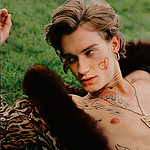
hi hello welcome 2 my twisted mind ☺️ marlowe is a character i’m still fine-tuning bc he’s brand-new, so this is unfortunately.... a bit of a mess.... and mostly made up on the spot.... c’est la vie!!
(a late addition but u can also peep his weheartit collection here 4 some vibes)
his government name is james marlowe but he only goes by marlowe & only introduces himself as marlowe like he’s madonna or sting.... most ppl who know him (apart from like close friends) probably don’t even know what his first name is. maybe he doesn’t have one!
hails from Appalachia, specifically a trailer park in a poor-as-dirt stretch of Virginia where he was born n raised, baby. he’s Appalachian white trash and not afraid to admit it. marlowe’s very casual about his upbringing and his dumpster fire of a family (no less than three relatives are currently incarcerated, one of which is his older brother who’s probably serving a minor sentence for whatever dumb shit Tim Riggins got got for in FNL or like, selling illegal fireworks out of his trunk :/ ). the only thing he’s a little self-conscious about is his twang which he’s mostly suppressed by now, but other than that, he’s got no shame in where he comes from bc lbr no authentic artist ever came from money anyway!
born sandwiched in the middle of five siblings, marlowe’s always been wild and creative and impulsive, a loud-mouthed kid with too much to say for his own good, prone 2 getting in trouble but learning absolutely nothing from it. it was his mission in life to be Different from all the other kids who grew up where he grew up, with the way he talked, dressed, acted, because he knew that he was destined for bigger n better things so it was just a matter of getting other ppl to believe it, & then seeing how far a little talent and a lot of charisma would take him >:)
from age 8 onwards, he told people he was an “artist” and that became his primary identity. when he was 16 he completed an independent sculpture project (called “Skyscraper”) where he constructed a 20-foot tower made out of junk collected from around the trailer park and then glued Barbies n other dolls all clawing over each other to get to the top, smack dab in the middle of Main Street and refused to take it down even when the local fire department showed up 2 threaten him with fines. it did eventually get taken down bc it was ‘structurally unsound’ and someone nearly got concussed by a falling mannequin head, but at least it got some attention from local newspapers and w/ that as the crown jewel in his portfolio, marlowe got into a few different art/liberal arts schools the following year. radcliffe was the only one who offered a partial scholarship and the east coast sounded nice n far from home, so anyways lets go ✈️ college
FAST FORWARD its senior year babey and marlowe’s been making the most of his time here at radcliffe. he’s a fine arts major but specializes in mixed media sculptures (and probably is really shit at most of his other classes, like art theory where u actually have to read textbooks? still life drawing? boring. yawn. won’t do it.) his entire profile as an artist i’m cribbing from Rachel Harrison bc I saw her exhibition at the whitney a little while ago and her sculptures made me go ?????¿¿¿¿¿ which i think is exactly the kind of bizarre nonsense that marlowe is going for with his “art”. feast your eyes on these masterpieces. the joke of it all is that marlowe is the first to admit that his art isn’t like.... good. but his philosophy is that if people respond to it & praise it like it’s art, then by definition, it’s art. and if it gets him places (like it got him onto Cultured Magazine’s “30 Young Artists To Watch This Decade″ list), then yeehaw!
When he’s not busy creating new monstrosities, marlowe takes one fat nap per day (usually at a time when he has class) and is otherwise a very social creature who needs constant attention. he’s got a lot of friends and is always looking to make more, not in a #fake way but just as a person who genuinely likes being around people. he very quickly gets bored if left on his own, so he’s prone to following people around campus like a stray cat regardless of whether or not they tell him to shoo. he dorms at Noland but is almost always found in other houses, often crashing in other people’s rooms (needs to be close to his friends or He’ll Die), and he definitely frequents parties, bc marlowe never passes up an opportunity to drink other people’s booze and get a lil messy and Chaotic. he’s [jim halpert voice] not a slut, but who knows? he’s kinda a slut! he’s also definitely pulled another stunt similar to Skyscraper by taking over the quad for a guerrilla art installation with his sculptures (and without the school’s permission oops) which may be the basis for some connections if ppl know him from that particular exploit!!
in summary..... marlowe can be a bit up his own ass at times, but being around him is generally a Good Time bc he’s easy-going and friendly and always down for anything, always. litcherally zero impulse control so nothing gets in the way of a dumb idea that might potentially make for a good story. perhaps he’s not the most reliable person, so don’t expect a prompt text back if ur in a life or death situation, and he doesn’t care very much about anything, so ur setting urself up for disappointment if you do expect him to care about something (the fact that he’s never been in a long-term relationship... very telling). all he wants to do is just have! fun all the time! he’s trying to scam his way into the American Dream with his dumb art, so that he can live a good life and maybe get rich and famous and eventually party at Art Basel in Miami with Frank Ocean! is that really so much to ask!
appearance: marlowe’s very vain and a lot of thought goes into his appearance even when (especially when) it doesn’t look like he’s done anything but roll straight out of bed. all of his outfits are as outrageous as his sculptures are ugly. think mismatched prints and loud colors, silk shirts gaping open like he got tired after the first three buttons, a pawn’s shop worth of jewelry, weird dangly earrings w/ feathers or tiny charms, tinted yellow or pink sunglasses, sometimes a bandana around his neck, just for extra flavor. his hair always has to look perfectly tousled; u can catch him checking out his reflection in pretty much every mirrored surface. at least half the surface area of his body is covered in tattoos & he’ll suggest getting more during every drunken night out, which... is why he has so many by now!
connections: to be quite honest its 2 am and i feel all of my higher brain functions shutting down so i’m gonna make these very simple n straightforward, but we can always workshop!!!! pls feel free to message me even if none of these strike ur fancy :0)
peers in the arts - friends, acquaintances, rivals, probably some former group project members holding a grudge....
fellow party animals who don’t mind sharing when marlowe inevitably mooches off their alcohol and drugs :)
unlikely friends!!!!! it’d be fun to have a friendship dynamic with someone who’s very different from him!!
a roommate in Noland... possibly one he’s not on good terms w/... even tho marlowe hardly EVER sleeps in his own dorm room, he uses it as a storage locker for all his “found” art materials. i can imagine that living in that mess would try the limits of anyone’s sanity :)
enemies - they can hate his whole Genius Artist shtick and they’d be valid :/
fellow insomniacs! marlowe is very much a night owl (regular naps during the day may be 2 blame but oh well) so he needs a fellow nocturnal to hit up the late-night McDonald’s drive thru with him and then lay on the grass lookin at the stars and contemplating life’s great mysteries while eating chicken mcnuggets
exes - idk if u can even call them tht when his past “relationships” have all had a lifespan of six weeks or less, but hey there’s drama in that too!!
fwb - i don’t think marlowe’s the type 2 be juggling too many fwb/hook-ups at one time simply because That’s A Lot of Work. that being said... he never likes to sleep alone ;)
#radintro#im working on some gif icons but full disclosure.... they gon be sparse and shitty!#so instead we have this pic where it looks like he passed out on a lawn and woke up w/ shit scribbled all over his face#and u know what? on brand#anyways plot w/ me!!!!!!#about
17 notes
·
View notes
Text
just finished rewatching toy story 1 thru 3 over the past few days, wanted to share my thoughts:
i love these movies a whole lot. the first 2 hold a bunch of nostalgia for me because i was A Baby when 2 came out and when i was also A Baby i would just watch our VHS copy of toy story 1 over and over again. this also makes me the exact age group to be emotionally destroyed by toy story 3, which came out just as i was entering high school and hit really close to home
individual thoughts:
toy story: the first thing i noticed was it still looks really nice even watching in 2019!! which i think is kind of spectacular for the first feature-length computer-animated film. it no doubt helps that the plot is mostly focused on little plastic dolls without realistic hair or clothing to animate but the semi-”cartoon” art direction means the human characters also look pretty nice without going too far into the uncanny valley.
also, the plot is WAY darker than i remember?? not because of sid and all the body horror toys, but because for like half of the movie woodys friends think hes an actual (toy) murderer carrying around the severed arm of his victim (!!) like, its hilarious, but also wow theres a LONG way to go between there and the climax of toy story 3.
the soundtrack is probably my favorite of the bunch. part of that is probably nostalgia but i just really like the consistency of having randy newman singing every song. it sort of elevates him to part of the story, like an omniscient narrator singing woodys (and later buzzs) inner monologue. 2 (and especially 3) didnt have as many musical numbers, which i can understand with a shift to a larger-scale approach to storytelling, but i really like the feeling it gives number 1. “you got a friend in me” is an obvious classic thats been remixed and brought back in just about every piece of toy story media im aware of, but “strange things” and “i will go sailing no more” deserve just as much recognition and praise. there just isnt a weak number among them
toy story 2: heres where the story started getting bigger and more existential, which basically becomes the new direction of the series. which makes sense! this one released 4 years after the first, and while theres no real timeskip in the story (maybe 6 months?) it had been a little while since we last saw woody and the gang. everybody in the real world had gotten older, and with the turn of the millennium approaching, the theme of impermanence loomed large in the collective unconscious. well, maybe not in my unconscious, because i was 2. but its really interesting as kind of a “time capsule” to what people were thinking about as the 90s came to a close.
so toy story 2 was a little more grounded, a little more focus on the human world, but it was also more fantastical in its presentation. the opening “video game” sequence (which still looks amazing!!) and woodys nightmare (”i dont wanna play with you anymore...”) show the animators at pixar really found their groove and started getting experimental. and to great result!! the fantasy sequences are a lot of fun and help 2 really stand out.
i would be remiss not to mention jessies flashback song here. its something else they hadnt really done in the first film and i think it really works. jessie in this film unfortunately doesnt get to do much other than fight with woody about whether he should stay or go (except for when she saves him in the end) but this song makes her character work. it also helps that it destroys me every time
also i think this is the movie that gave me an appreciation for the acting of kelsey grammer. i dont really agree with his politics (i also dont know specifically what they are) but he is a damn fine actor and gives the prospector a very genuinely intimidating edge after his heel turn. the casting really makes the character here, but thats nothing new for toy story-- every voice works. if i were the casting director, i probably wouldnt have pulled erudite kelsey grammer for a character named “stinky pete,” but as it is now i couldnt imagine him voiced by anyone else.
the last thing about toy story 2 is it feels like there were a lot more pop culture references? at least as far as i noticed. there are apparently even more than i noticed but i caught on to the “also sprach zarathustra” riff in the opening, and the jurassic park rearview mirror gag. and of course the extended star wars reference with zurg vs. utility belt buzz (and i guess zurg in general.) the references are cute and mostly unobtrusive but really i could take or leave them.
oh yeah also al is hilarious. just this rude, neurotic businessman whos incredibly self-important for the owner of a minor(?) toy store chain. hes such a puffed-up jerk, every time hes on-screen is a delight
toy story 3: this one kills me to death. i always get misty-eyed during “when somebody loved me” but the ending of 3 where andy introduces his toys to bonnie and plays with them one last time made me sob the first time i watched it. and it still does! thats the long game right there, thats the payoff of over 10 years loving these characters. its an emotional ketchup bomb, everything gets all messy and soggy and sweet. hopefully 4 can follow up, but im not really worried about that-- ive heard some good things. damn, its been 9 years since this movie came out, though! it really doesnt feel all that long, but i guess i havent been doing all that much
i actually dont know if i have much else to say about 3. the opening with the re-imagining of the previous films openings (woody versus one-eyed bart, buzz and woody vs. the evil dr. porkchop) is a highlight, although theres a conspicuous lack of bo peep. ive heard she has a big part in 4, but it was kind of weird to see a lot of toys missing and their absence (mostly) glossed over after the first few minutes. i miss r.c. and lenny, but i get they wanted to narrow down the cast so all of them could get in on the plot.
speaking of which, the escape scene is great too. its kind of a crystallizing moment of how close these characters are, and how well they work together. it reminds me a lot of the escape from sids house in the first movie, but there woody was working with sids body-horror toys and seemed to strike up a rapport with them bizarrely quickly. (speaking of which, i miss those toys! their designs were super cool, but i cant imagine they got much merchandise, especially babyface with the sharp, metal spider legs.) here, though, woody and the gang cooperate the best they ever have, and it really paints a picture of how close theyve become over the years, and justifies the emotional climax in the landfill. this is what i was talking about when i said i was surprised how dark toy story 1 got! these toys all hated woodys guts back then for what they thought he did to buzz. they kicked him out of a moving truck! its just weird to think about that conflict between them when you know how long they end up sticking together. but thats, like, neat, so its ok. it feels earned, its just kind of crazy in hindsight.
toy story 3 was also obviously made long after the first two-- by comparison, the lighting is way more sophisticated, the humans are a lot more detailed. theres just a lot more detail In General. the main cast is, like, super dirty for the middle 90% of the film, and it feels like, yeah, We Have This Technology Now. we can render so many individual glitter sprinkles suck to hamms ass and they will be in every single scene. the “fur tech” on lotso and buster is also an obvious clue, especially in the flashback to lotso trudging through the rain back to his owners house. its like “look! we can make this teddy bear SO wet!” and wow! yeah! you did! so wet!
lotso himself is also an interesting villain in terms of sheer bastardness. he is just a huge jerk. he could have hit that button so easily! and he was so mean to the baby! but at the same time hes a great character in how he slowly “changes” throughout the movie. he is kind of an obvious “pixar ‘twist’ villain” but again, the amazing performance by ned beatty really saves him. also he does get a nice comeuppance at the end, which was necessary because hes really the biggest villain in the series so far. hes knowingly malicious and doesnt have any greater motive, hes just an embittered megalomaniac who (apparently) has sent other toys to be broken, thrown away, and incinerated at the landfill. he honestly deserves worse than being strapped to the front of a truck but it works for a family movie.
i have a couple more thoughts on 3 (i guess i did have a fair amount of stuff to say about it) but im getting tired of writing. the music is good as usual, but the vocal stuff being entirely back-loaded (in the credits) is a bit disappointing since ive always been a fan of the songs, but i get that they were going for something different. the jokes about ken being, uh, ‘flamboyant’ felt out of place, mostly the one at the end (”uh, buzz? barbie didnt write this”) because it comes from one of the gang and not unnamed lotso goon #3, but i guess its pretty tame in the scheme of things.
overall im really looking forward to seeing what 4 does with the series. whew!
4 notes
·
View notes
Text
The Boob dilemma (totally a clickbait title)
One of my favorite things about the outrage and discourse that arised back when the character design for She-ra, from the 2018 She-ra reboot, made their debut is how on one side of the argument we had men in their forties complaining at how the new design completely destroyed their prenotions of what the character of She-ra should look like, hence feeling like an ultimate attack from the millenial generation toward the pop culture of their youth in an attempt to strip them from what once was part of their identity while at the same time appropiating that identity. And they were also mad that she looked like a boy.
And on the other side of the argument we had a group of very strong voices expressing their content at the fact these men could not get any sexual satisfaction from this character anymore.
What entices me the most about this argument is how they don’t seem to even be arguing against each other, but at some sort of nondescript enemy. By the time the original She-ra came out, He-man was already a phenomenon among boys and girls alike, and we know this because little girls love action-adventure shows and that was exactly why Mattel wanted to cash on this fact, by releasing new girl-oriented characters in the MotU toyline. And that’s how Filmations’ She-ra the Princess of Power came to be. And being the first ever created action-figure series for girls, she was groundbreaking in every way. What they didn’t expect tho, was that boys became invested in this new show as well, because we all know boys love inspiring heros regardless of their gender, and she actually got to be more popular among them than among girls at the time.
So, seeing as the audience of these two shows and that the target market of these toys were children, it’s safe to assume these boys weren’t really getting any sort of sexual satisfaction from the design of the characters. And I can hear what you’re saying: But these boys grew up! They became creepy men that sexualize teenage female characters and complain about boobs!
Those are very acceptable points, but following that idea, we have to take in mind that by the time these kids reached puberty, these characters became part of the sexual awakening and identity for a lot of them, girls and boys alike. Not to mention, the idea for She-ra and He-man was that they were full adult versions of Adora and Adam, and that shows in the designs and animation. Adora and Adam themselves didn’t look that younger either, probably because a lot of animated shows from the 80s had 15 y/o and up teenagers looking like they were in their 30s (Saint Seiya), and probably so they didn’t have to fabricate very different doll molds for the toys production (okay, we know this is the reason).
But She-ra wasn’t a sexual icon any more than Barbie or Xena were. And the one thing Xena and She-ra have in common aside from being badass warrior princesses AND fashion icons of the fantasy genre is that they sported what I like to call the short short skirt, which takes me to my next point: The clothes.
The clothes design for the new She-ra is casually pretty, casually comfortable and casually fit of the teenage character she fully represents now. And she also wears shorts. That called my attention because there was not a single scene in which you could see under the skirts of any of the two aforementioned ladies. In fact, there was a law stablished by the Executive Producer and the Animation Coordinator of the 80s She-ra that prohibited any shot of her panties, no matter how high her leg went up or if she was doing acrobatics. While there was always a black shadow under the heavy layers of leather Xena wore whenever she threw one of her famous kicks. Anyone could still argue these outfits were “slutty”, but the negative note in this statement would contradict the notion that girls are allowed to feel comfortable with their bodies and sexuality while expressing themselves and shouldn’t be ashamed for what they choose to wear, also, that their clothes shouldn’t influence at all the way men react and behave around them, so I’m gonna assume people who use this argument are just tired of seeing these costumes in Halloween.
Now onto my second to last point: Boobs. Yeah, no, I’ve got nothing here. Some people are just obsessed with boobs, even in cartoons. No boobs, no woman, apparently. Imagine WonderWoman without boobs. I guess she’s suddenly a guy. Having the words ‘woman’ or ‘she’ in their hero names aren’t indicative enough of their gender.
Which allows me to address my final point: Body diversity. MotU lacked this one, mostly so Mattel could save money on toy production costs (and maybe also animation costs for Filmation, that got to reuse and redraw many frames), which makes the character design of the 2018 reboot an evident and refreshing improvement. But often, when I see The Discourse play out, a popular counter argument against 80s fans is brought up: That She-ra’s new body is simply better because it actually reflects her age and because she looks strong instead of traditionally feminine, no longer having a thin waist and hourglass figure which are sexist features. The core problem of this argument is that girls like this exist. The idea that one body type is inherently better than another is already incorrect, but there are young girls whose genetics make their bodies develop faster. Are these girls reinforcing sexism? And what about femininity? Is there only one right way to exercise it?
There really isn’t anything wrong with the original She-ra (aside from the one body-one face syndrome the characters were subjected to). It was a happy and colorful show that taught girls and boys alike valuable lessons like having confidence in themselves and doing the right thing, and also had silly mascots.
The 2018 She-ra seems like a refined version of this, with diverse characters and a central conflic that explores the close relationship between love and hate, childhood abuse, trauma and the way stereotypes are used as a war tactic to take down entire populations. While staying goofy from beginning to end despite all that.
I guess what I’m trying to say is, it’s possible to enjoy both versions. Actually, it isn’t if you’re younger than 30. The pacing and stiff animation of the 80s one had me falling asleep every episode. But my point is that the original She-ra is not bad because of the reasons people like to use, and that a lot of 80s fans, mainly the ones not obsessed with boobs, just feel alienated from a franchise they used to know so well but that was reformed.
#she-ra discourse#i'm not really adding to the discourse just saying there's no need to fight#our awesome warrior ladies have taught us acceptance and friendship#not dividing over petty reasons#mine#text
13 notes
·
View notes
Note
🔥 gimme the salt on poto
Satly Saturday | Buckle Up. | Accepting!
Do you want ALL THE SALT or just some of it? Because i feel like I could write a dissertation on everything wrong with PotO and, more specifically, the Phandom and be only a diploma shy from my doctorate.
One of the things I’m incredibly angry about is that it is still an “unpopular opinion” that Meg Giry is anything but blonde and white. In the novel, she is described as “swarthy” with dark hair and eyes, but even if that were not the case, who does it harm to headcanon her as a WoC? I think it is much more damaging to ascribe white traits and white traits only to her, not only because in the Leroux text, she is not white, but because other interpretations of PotO, whether they be the stage show or a roleplay portrayal, should be more open to diversity in general. The world is diverse. And the world was diverse in the 19th century. Historians, novelists, and filmmakers tend to whitewash history and create a false monolith of Europe and the Americas, except when it furthers a particular narrative (typically revolving around the American South, even when the American South has no bearing on a story, like PotO, which takes place in a different country altogether). It’s disgusting.
The thing that gets me, though, is that the Phandom largely just accepts that Meg Giry is white and blonde. That’s the way it is in the stage show and since stage shows (and their subsequent film adaptations) are visual mediums, whereas novels rely on imagination, it’s “easier” to use images from the show to make aesthetics, fan art, etc. about Meg. It’s pure laziness most of the time; ignorance in other instances. This, to me, is dangerous in a different way than adamantly demanding Meg Be White for thinly veiled reasons tied up in racism. We know the latter is wrong. We take people to task on the latter. We demand more and better from our fandoms than casual, but intentional, racism. When it’s unintentional… or when it’s intentional because 99 percent of media including Meg Giry whitewashes her, we still hit that like button or that reblog button, instead of demanding better from our fandoms. I’m not calling for people to spam content creators with vitriol over their blonde, cherubic Meg Girys. I am calling for people to create more black Meg Girys, more Asian Meg Girys, more Jewish Meg Girys, more Latina Meg Girys, more Middle Eastern Meg Girys. Take what precious little Leroux gave us about her and expand your interpretation. Be kind to interpretations that are racially/ethnically different than the norm, or even than your own. The headcanons someone is posting about a Romani Meg Giry might be their way of connecting their own heritage to the text, of seeking representation that was hinted at in the book and destroyed in later interpretations. The fan art of a black Meg Giry might be a young woman’s way of seeing herself or her friends or her sisters in an art form (ballet) that has traditionally been unkind to WoC. Meg as a woman of color is so important - especially when you dare to mash up Leroux with ALW because the traits they each give her, when put together, create a complex and nuanced young woman that anyone might be happy to identify with. Whitewashing her takes that opportunity away from fans, especially young fans, who do not otherwise see themselves reflected in this beautiful melodrama. Ad who wants to be the gate keeper to a world of fun and joy? The ones we should be taking to task are the casting directors of PotO productions - especially in the US and UK, since those shows are most widely seen and publicized. Not just the ALW show (although I do hold the ALW show responsible for whitewashing Meg in the first place), but future productions of PotO by other creators.
I also think that for people who aren’t fans of Meg, who don’t pay her much mind, don’t understand why this is such a contentious issue for those of us who love her, whether we love her from Leroux, Webber, or another iteration. For me, the version I take issue with is the ALW version… largely because I believe ALW Meg to be a composite of Meg Giry, La Sorelli, and Cecile Jammes from the Leroux novel. You see traits of each woman reflected in ALW Meg. She’s aged up, perhaps not prima ballerina, but a principal dancer. She’s superstitious, but level-headed. Kind, almost maternal, but bubbly and fun. She’s bold and fascinated by the strange goings-on around her. If ALW had wanted to give her the blonde, blue-eyed good looks of a Barbie Doll, he would have done better to name her after Jammes, who has a peaches and cream complexion in the novel. He could have even named her after Sorelli, though this move would have been more difficult, since Sorelli was a principal dancer and not the daughter of one of Erik’s employees. No. He chose to name her after Meg Giry and elevate her to secondary character status. The least he could have done was make her look the part. It would not have been the first time a principal cast member in an ALW was a PoC. Ben Vereen played Judas in the Broadway debut of JCS. So, why so scared to cast a black woman (or, really, any WoC) as Meg Giry? Come on, ALW. Would it have been so hard? It could have started the conversation about race in period dramas or the conversation about racism in the fine arts (especially ballet) twenty or thirty years earlier. And even if it didn’t, PotO would still be the beautiful leviathan it is today.
Of course, I know that in a post-LND world, a lot of people have bigger complaints about Meg Giry’s treatment in modern stagings. I agree with them - the characterization of Meg Giry in LND is painful to watch. It’s inconsistent with what we know of her in the original show; it certainly is divorced from the novel in all ways. The flaws with Meg’s character in LND have nothing to do with the fact that she’s made into a sex worker (although that choice is questionable from a narrative standpoint, not a moral one. What does it add to Meg’s arc that she sold herself to help buy Phantasma? The implication that we’re meant to see her as lesser than Christine for it is the real moral quandary, But I digress). Rather, the flaws with Meg’s character stem from her being inconsistent with all previous and recognizable versions of her character and with the anti-feminist need to pit two women, who were previously the best of friends, against each other over a man… Not even a man who treats one or both of them right… like… it pits two best friends against each other over an abusive narcissist. It does no characters any favors, least of all poor Meg, who is made out to be needy, jealous, emotionally unstable… It does a poor job getting from Point A to Point B.
This bastardization of Meg’s character would probably seem like a great bullet to dodge, insofar as representation goes. I think it would be absolutely disgusting to cast a black woman as LND Meg, due to all the negative stereotyping that would end up clouding even the best performance. However, LND was not the commercial or critical success ALW hoped it would be. Not even close. It underwent a lot of rewritings, still was not highly successful, and (by and large) disappoints both fans of the original story and newcomers to the PotO story. It is nowhere near the cultural phenomenon that PotO is. And so, then, again I ask - why have we not seen a WoC in the role of Meg? It’s only very recently that we’ve seen PoC in the roles of Christine, the Phantom, and Raoul. Meg is still depicted as white. I’m hoping that the trend of diversifying Broadway is more than a trend, but instead a cultural shift in how Broadway appeals to the masses. I hope to see a WoC play Meg (and Madame Giry, who I’ve neglected to mention until now, woops) within my lifetime.
Honestly, I think that I only really started thinking about this critically two years ago when my Salt Squad and I got talking about representation in the Phandom, particularly in the RPC. I was rereading Leroux at the time and meditating on Kay (as one does) in my spare time and it occurred to me that if I wanted to see some change in the Phandom, I had to be a part of the side I wanted to see prevail. I had to be some of the change I wanted to see in the Phandom. So I took up Meg as a muse. I’m starting to see more and more racially diverse Megs in the Phandom and that thrills me. I want to @fillescharmxnt because her Meg is what I aspired for mine to be in so many ways. There are plenty of other fanartists, fic writers, and aesthetic makers who are doing such great things with recontextualizing Meg Giry for the 21st century.
I do want to include this disclaimer, though: just because someone is roleplaying, writing, drawing, headcanoning Meg as white, doesn’t mean that their ideas are without merit. There are plenty of very talented artists, writers, and bloggers who depict Meg as white. My goal is not to shame them - a lot of them do great work, both from a technical and emotional standpoint - but rather to invite them to the conversation about Meg Giry, race, and representation. I urge these fans to challenge their notions about Meg Giry and to be open to accepting ideas that are different from theirs. Even those of us who HC Meg as a WoC enjoy and support content with blonde Meg (like… can we talk about the Brazilian actress with the freckles?!). All I ask is that fans of white Meg Giry enjoy and support content with black/Asian/Jewish/Romani/Latina/Middle Eastern/Other Meg Giry in return.
Fans can question the media they consume. Fans can challenge the media they consume. But at the end of the day, it is the media that we create and ask to be created that make the most difference. The only way media gets created is if there is a demand for. Be willing to demand a more inclusive, more historically accurate depiction of Meg Giry and you will be rewarded with a creative explosion of fan created content.
10 notes
·
View notes
Link
A child opens a box. He starts jumping and screaming with joy—not an unusual sound in the halls of Mattel’s headquarters where researchers test new toys. But this particular toy is a doll, and it’s rare for parents to bring boys into these research groups to play with dolls. It’s rarer still for a boy to immediately attach himself to one the way Shi’a just did.
An 8-year-old who considers himself gender fluid and whose favorite color is black one week, pink the next, Shi’a sometimes plays with his younger sister’s dolls at home, but they’re “girly, princess stuff,” he says dismissively. This doll, with its prepubescent body and childish features, looks more like him, right down to the wave of bleached blond bangs. “The hair is just like mine,” Shi’a says, swinging his head in tandem with the doll’s. Then he turns to the playmate in the toy-testing room, a 7-year-old girl named Jhase, and asks, “Should I put on the girl hair?” Shi’a fits a long, blond wig on the doll’s head, and suddenly it is no longer an avatar for him, but for his sister.
The doll can be a boy, a girl, neither or both, and Mattel, which calls this the world’s first gender-neutral doll, is hoping its launch on Sept. 25 redefines who gets to play with a toy traditionally deemed taboo for half the world’s kids. Carefully manicured features betray no obvious gender: the lips are not too full, the eyelashes not too long and fluttery, the jaw not too wide. There are no Barbie-like breasts or broad, Ken-like shoulders. Each doll in the Creatable World series looks like a slender 7-year-old with short hair, but each comes with a wig of long, lustrous locks and a wardrobe befitting any fashion-conscious kid: hoodies, sneakers, graphic T-shirts in soothing greens and yellows, along with tutus and camo pants.
Mattel’s first promotional spot for the $29.99 product features a series of kids who go by various pronouns—him, her, them, xem—and the slogan “A doll line designed to keep labels out and invite everyone in.” With this overt nod to trans and nonbinary identities, the company is betting on where it thinks the country is going, even if it means alienating a substantial portion of the population. A Pew Research survey conducted in 2017 showed that while 76% of the public supports parents’ steering girls to toys and activities traditionally associated with boys, only 64% endorse steering boys toward toys and activities associated with girls.
For years, millennial parents have pushed back against “pink aisles” and “blue aisles” in toy stores in favor of gender-neutral sections, often in the name of exposing girls to the building blocks and chemistry kits that foster interest in science and math but are usually categorized as boys’ toys. Major toy sellers have listened, thanks to the millennial generation’s unrivaled size, trend-setting ability and buying power. Target eliminated gender-specific sections in 2015. The same year, Disney banished “boys” and “girls” labels from its children’s costumes, inviting girls to dress as Captain America and boys as Belle. Last year, Mattel did away with “boys” and “girls” toy divisions in favor of nongendered sections: dolls or cars, for instance.
But the Creatable World doll is something else entirely. Unlike model airplanes or volcano kits, dolls have faces like ours, upon which we can project our own self-image and anxieties. Mattel tested the doll with 250 families across seven states, including 15 children who identify as trans, gender-nonbinary or gender-fluid and rarely see themselves reflected in the media, let alone their playthings. “There were a couple of gender-creative kids who told us that they dreaded Christmas Day because they knew whatever they got under the Christmas tree, it wasn’t made for them,” says Monica Dreger, head of consumer insights at Mattel. “This is the first doll that you can find under the tree and see is for them because it can be for anyone.”
The population of young people who identify as gender-nonbinary is growing. Though no large surveys have been done of kids younger than 10, a recent study by the Williams Institute at the University of California, Los Angeles, found that 27% of California teens identify as gender-nonconforming. And a 2018 Pew study found 35% of Gen Z-ers (born 1995 to 2015) say they personally know someone who uses gender-neutral pronouns like they and them, compared with just 16% of Gen X-ers (born 1965 to 1980). The patterns are projected to continue with Generation Alpha, who were born in 2010 and later. Those kids, along with boys who want to play with dolls and girls who identify as “tomboys” and don’t gravitate toward fashion doll play, are an untapped demographic. Mattel currently has 19% market share in the $8 billion doll industry; gaining just one more point could translate to $80 million in revenue for the company.
Mattel sees an even broader potential for Creatable World beyond gender-creative kids. In testing, the company found that Generation Alpha children chafed at labels and mandates no matter their gender identity: They didn’t want to be told whom a toy was designed for or how to play with it. They were delighted with a doll that had no name and could transform and adapt according to their whims.
Photograph by Angie Smith for TIME. Shi’a, left, and Jhase play with Mattel’s gender-neutral doll
But it’s parents who are making the purchasing decisions, and no adult is going to have a neutral reaction to this doll. In testing groups, several parents felt the “gender-neutral” branding of the toy pushed a political agenda, and some adults objected to the notion of their sons ever playing with dolls. Mattel’s President Richard Dickson insists the doll isn’t intended as a statement. “We’re not in the business of politics,” he says, “and we respect the decision any parent makes around how they raise their kids. Our job is to stimulate imaginations. Our toys are ultimately canvases for cultural conversation, but it’s your conversation, not ours; your opinion, not ours.”
Yet even offering customers that blank canvas will be seen as political in a country where gender-neutral bathrooms still stir protests. Mattel joins a cohort of other companies that have chosen a side in a divisive political climate. Just in the past two years, Nike launched a campaign starring Colin Kaepernick after the NFL dropped him from the league for kneeling during the national anthem to protest racism. Airbnb offered free housing to people displaced in the face of President Trump’s travel ban. Dick’s Sporting Goods stopped selling assault-style weapons after the Parkland shooting. All these companies have reported eventual sales bumps after staking their claim in the culture wars.
When pressed with these examples, Dickson admits that staying neutral is not an option if you want to be perceived as an innovator. “I think being a company today, you have to have a combination of social justice along with commerce, and that balance can be tricky,” Dickson says. “Not everyone will appreciate you or agree with you.”
In fact, dissent among boomers, Gen X-ers and even millennials may be a positive sign, according to Mattel’s own researchers. “If all the parents who saw the dolls said, ‘This is what we’ve been waiting for,’ we wouldn’t be doing our jobs,” says Dreger. “That would mean this should have already been in the market. So we’re maybe a little behind where kids are, ahead of where parents are, and that’s exactly where we need to be.”
***
Walking into Mattel’s headquarters, it’s difficult to imagine a gender-neutral world of play. A huge mural depicts some of the company’s most recognizable toys. A classic bouffanted version of Barbie in a black-and-white bathing suit and heels squints down at visitors. In another picture close by, a little boy puffs out his chest and rips open his shirt, Superman style, to reveal a red Mattel logo that reads “Strength and Excellence.” Even a toddler would be able to discern the messaging on how a woman and a man are expected to look from these images.
But the evolution within Mattel is obvious once visitors make their way past the entryway and into the designers’ cubicles. Inspiration boards are covered with pictures of boys in skirts and girls in athletic gear. The most striking images are mashups of popular teen stars: the features of Camila Mendes and Cole Sprouse, who play Veronica and Jughead on Riverdale, combine to create one androgynous face, and Millie Bobby Brown and Finn Wolfhard, who play the main characters on Stranger Things, blend into a single floppy-haired, genderless person with sharp cheekbones.
In the past decade, toy companies have begun to tear down gender barriers. Smaller businesses like GoldieBlox, which launched in 2012 and builds engineering toys targeting girls, and large companies like Lego, which created the female-focused Lego Friends line the same year, have made STEM toys for girls more mainstream. Small independent toymakers have pushed things further with dollhouses painted green and yellow instead of purple and pink, or cooking kits that are entirely white instead of decorated with flowers or butterflies.
Perhaps it’s surprising, then, that nobody has beaten Mattel to creating a gender-neutral doll. A deep Google search for such a toy turns up baby dolls or strange-looking plush creatures that don’t resemble any human who ever walked this earth. Nothing comes close to the Creatable World doll that Mattel has conjured up over the past two years.
Scientists have debunked the idea that boys are simply born wanting to play with trucks and girls wanting to nurture dolls. A study by psychologists Lisa Dinella and Erica Weisgram, co-editors of Gender Typing of Children’s Toys: How Early Play Experiences Impact Development, found that when wheeled toys were painted white — and thus deprived of all color signaling whether they were “boys’ toys” or “girls’ toys” — girls and boys chose to play with the wheeled toys equally as often. Dinella points out that removing gendered cues from toys facilitates play between boys and girls, crucial practice for when men and women must interact in the workplace and home as adults. She adds that millennials (born 1981 to 1996) have pushed to share child-care responsibilities, and that battle ought to begin in the playroom. “If boys, like girls, are encouraged to learn parental skills with doll play at a young age, you wind up with more nurturing and empathetic fathers,” she says.
And yet creating a doll to appeal to all kids, regardless of gender, remains risky. “There are children who are willing to cross those gender boundaries that society places on toys, but there’s often a cost that comes with crossing those boundaries,” Dinella says. “That cost seems to be bigger for boys than it is for girls.” Some of those social repercussions no doubt can be traced to parental attitudes. In Los Angeles, the majority of the seven parents in an early testing group for Creatable World complained the doll “feels political,” as one mom put it.
“I don’t think my son should be playing with dolls,” she continued. “There’s a difference between a girl with a truck and a boy with a Barbie, and a boy with a Barbie is a no-no.”
The only dad in the group shrugged: “I don’t know. My daughter is friends with a boy who wears dresses. I used to be against that type of thing, but now I’m O.K. with it.”
In videos of those testing groups, many parents fumbled with the language to describe the dolls, confusing gender (how a person identifies) with sexuality (whom a person is attracted to), mixing up gender-neutral (without gender) and trans (a person who has transitioned from one gender to another) and fretting about the mere idea of a boy playing with a doll. A second mom in Los Angeles asked before seeing the doll, “Is it transgender? How am I supposed to have a conversation with my kid about that?” After examining the toy and discussing gender-fluidity with the other parents, she declared, “It’s just too much. Can’t we go back to 1970?”
After the session, Dreger analyzed the parental response. “Adults get so tied up in the descriptions and definitions,” she said. “They jump to this idea of sexuality. They make themselves more anxious about it. For kids it’s much more intuitive.”
Why, exactly, a new generation is rejecting categorizations that society has been using for millennia is up for debate. Eighty-one percent of Gen Z-ers believe that a person shouldn’t be defined by gender, according to a poll by the J. Walter Thompson marketing group. But it’s not just about gender — it’s about authenticity, whether real or perceived. Macho male actors and glam, ultra-feminine actresses have less cultural cache than they used to. Gen Z, with its well-honed radar for anything overly polished or fake-seeming, prefers YouTube confessionals about battling everything from zits to depression. When the New York Times recently asked Generation Z to pick a name for itself, the most-liked response was “Don’t call us anything.”
Perhaps their ideas of gender have expanded under the influence of parents who are beginning to reject practices like gender-reveal parties that box kids in even before they are born. Jenna Karvunidis, who popularized the gender-reveal party, recently revealed on Facebook that her now 10-year-old child is gender-nonconforming and that she regrets holding the party. “She’s telling me ‘Mom, there are many genders. Mom, there’s many different sexualities and all different types,’ and I take her lead on that,” Karvunidis said in an interview with NPR.
Perhaps it’s that a generation of kids raised on video games where they could create their own avatars, with whatever styling and gender they please has helped open up the way kids think about identity. Perhaps the simple fact that more celebrities like Amandla Stenberg and Sam Smith are coming out as gender-nonbinary has made it easier for other young people to do the same. Generation Alpha, the most diverse generation in America in all senses of the term, is likely to grow up with even more liberal views on gender.
“This is a rallying cry of this generation,” says Jess Weiner, a cultural consultant for large companies looking to tap into modern-day markets and navigate issues of gender. “Companies in this day and age have to evolve or else they die, they go away … And part of that evolving is trying to understand things they didn’t prior.”
Photograph by JUCO for TIMEMattel, which calls this the world’s first gender-neutral doll, is hoping its launch redefines who gets to play with a toy traditionally deemed taboo for half the world’s kids.
Mattel isn’t the first company to notice the trend among young shoppers moving away from gender-specific products. Rob Smith—the founder of the Phluid Project, a gender-free clothing store that caters to the LGBTQ+ community in New York City—says several large corporations, including Mattel, have approached him for advice on how to market to the young masses. “I work with a lot of companies who are figuring out that the separation between male and female is less important to young consumers who don’t want to be boxed into anything,” he says. “There’s men’s shampoo and women’s shampoo, but it’s just all shampoo. Companies are starting to investigate that in-between space in order to win over Gen Z.”
Still, Mattel enters a politically charged debate at a precarious moment for corporations in America, where companies that want to gain customer loyalty are being pushed to one aisle or the other. A study from the PR agency Weber Shandwick found 47% of millennials think CEOs should take stances on social issues. Some 51% of millennials surveyed said they are more likely to buy products from companies run by activist CEOs. Now, if you walk into a Patagonia store, you’ll see a sign that reads, “The President stole your land. Take action now.”
Such activism is often born of self-interest: companies want to appeal to liberal customers and retain young employees and their allies. They face little risk by speaking up, but major consequences by sitting on the sidelines. In August, customers boycotted Equinox and SoulCycle—two companies that have aggressively courted the LGBTQ+ community—when reports emerged that their key investor was holding a fundraiser for Trump with ticket prices as high as $250,000. According to data analyses by Second Measure, a month later, SoulCycle attendance is down almost 13%.
Weiner says SoulCycle’s experience should serve as a cautionary tale. “I think businesses of any size now recognize that their consumer base values transparency over any other attribute. They want to know that your board is reflective of your choices, and that’s caught a lot of businesses off guard,” Weiner says. “You can’t talk about gender equity in your commercial and then have no women on your board. They have to be savvy.”
Now, a toy company has chosen to make a product specifically to appeal to the progressive part of the country. Lisa McKnight, the senior vice president of the global doll portfolio at Mattel, says major retailers have been enthusiastic about Creatable World. “They’re excited about the message of inclusivity,” she says. “The world is becoming a more diverse and inclusive place, and some people want to do more to support that.” When pressed on the risks, she lays out the alternative. “Candidly, we ask ourselves if another company were to launch a product line like this, how would we feel? And after that gut check, we are proceeding.”
Photograph by Angie Smith for TIMEThe dolls faces betray no obvious gender: the lips are not too full, the eyelashes not too long and fluttery, the jaw not too wide. Here, the dolls faces are painted at Mattel’s headquarters on September 5.
Mattel will launch Creatable World exclusively online first, in part to better control the message. That includes giving sneak previews to select influencers and leaders in the LGBTQ+ community. Selling the doll in retail stores will be more complicated. For one thing, there’s the question of where to place it in stores to attract the attention of shoppers who might not venture into a doll section. Store clerks will have to be trained in what pronouns to use when talking about the doll and how to handle anxious parents’ questions about it. And then there are practical concerns. Dickson admits the company is ready for the possibility that protests against Creatable World dolls could hurt other Mattel brands, namely Barbie.
Mattel has taken risks before. Most recently, in 2016, it added three new body types to the Barbie doll: tall, petite and, most radically, curvy. It was the first time the company had made a major change to one of the most recognizable brands—and bodies—in the world in the doll’s almost-60-year history. The change helped propel Barbie from a retrograde doll lambasted by feminists for her impossible shape to a modern toy. She is now on the rise. Her sales have been up for the last eight quarters, and she saw a 14% sales bump in the last year alone, according to Mattel.
But Mattel felt late to the game when it changed Barbie’s body: For years the Mindy Kalings and Ashley Grahams of the world had been championing fuller body types. Parents had been demanding change with boycotts and letter campaigns. By contrast, Creatable World feels like uncharted territory. Consider children’s media: Disney hasn’t introduced a major gay character in any of its movies, let alone a gender-nonconforming one. There are no trans superheroes. Even characters whose creators say they are queer—like Dumbledore in the Harry Potter series—haven’t actually come out on the page or the screen. In that pop-culture space, a gender-neutral doll seems radical.
Even though there is no scientific evidence to prove that this is the case, there will be customers who say that even exposing their children to a gender-nonbinary doll through commercials or in a play group would threaten to change their child’s identity. This debate will spin out into sociopolitical questions about whether the types of toys children play with affect their sense of identity and gender.
That conversation, if it comes, is worth it, according to Dickson. “I think if we could have a hand in creating the idea that a boy can play with a perceived girl toy and a girl can play with a perceived boy toy, we would have contributed to a better, more sensitive place of perception in the world today,” he says. “And even more so for the kids that find themselves in that challenging place, if we can make that moment in their life a bit more comfortable, and knowing we created something that makes them feel recognized, that’s a beautiful thing.”
0 notes
Link
September 25, 2019 at 12:01AM
A child opens a box. He starts jumping and screaming with joy—not an unusual sound in the halls of Mattel’s headquarters where researchers test new toys. But this particular toy is a doll, and it’s rare for parents to bring boys into these research groups to play with dolls. It’s rarer still for a boy to immediately attach himself to one the way Shi’a just did.
An 8-year-old who considers himself gender fluid and whose favorite color is black one week, pink the next, Shi’a sometimes plays with his younger sister’s dolls at home, but they’re “girly, princess stuff,” he says dismissively. This doll, with its prepubescent body and childish features, looks more like him, right down to the wave of bleached blond bangs. “The hair is just like mine,” Shi’a says, swinging his head in tandem with the doll’s. Then he turns to the playmate in the toy-testing room, a 7-year-old girl named Jhase, and asks, “Should I put on the girl hair?” Shi’a fits a long, blond wig on the doll’s head, and suddenly it is no longer an avatar for him, but for his sister.
The doll can be a boy, a girl, neither or both, and Mattel, which calls this the world’s first gender-neutral doll, is hoping its launch on Sept. 25 redefines who gets to play with a toy traditionally deemed taboo for half the world’s kids. Carefully manicured features betray no obvious gender: the lips are not too full, the eyelashes not too long and fluttery, the jaw not too wide. There are no Barbie-like breasts or broad, Ken-like shoulders. Each doll in the Creatable World series looks like a slender 7-year-old with short hair, but each comes with a wig of long, lustrous locks and a wardrobe befitting any fashion-conscious kid: hoodies, sneakers, graphic T-shirts in soothing greens and yellows, along with tutus and camo pants.
Mattel’s first promotional spot for the $29.99 product features a series of kids who go by various pronouns—him, her, them, xem—and the slogan “A doll line designed to keep labels out and invite everyone in.” With this overt nod to trans and nonbinary identities, the company is betting on where it thinks the country is going, even if it means alienating a substantial portion of the population. A Pew Research survey conducted in 2017 showed that while 76% of the public supports parents’ steering girls to toys and activities traditionally associated with boys, only 64% endorse steering boys toward toys and activities associated with girls.
For years, millennial parents have pushed back against “pink aisles” and “blue aisles” in toy stores in favor of gender-neutral sections, often in the name of exposing girls to the building blocks and chemistry kits that foster interest in science and math but are usually categorized as boys’ toys. Major toy sellers have listened, thanks to the millennial generation’s unrivaled size, trend-setting ability and buying power. Target eliminated gender-specific sections in 2015. The same year, Disney banished “boys” and “girls” labels from its children’s costumes, inviting girls to dress as Captain America and boys as Belle. Last year, Mattel did away with “boys” and “girls” toy divisions in favor of nongendered sections: dolls or cars, for instance.
But the Creatable World doll is something else entirely. Unlike model airplanes or volcano kits, dolls have faces like ours, upon which we can project our own self-image and anxieties. Mattel tested the doll with 250 families across seven states, including 15 children who identify as trans, gender-nonbinary or gender-fluid and rarely see themselves reflected in the media, let alone their playthings. “There were a couple of gender-creative kids who told us that they dreaded Christmas Day because they knew whatever they got under the Christmas tree, it wasn’t made for them,” says Monica Dreger, head of consumer insights at Mattel. “This is the first doll that you can find under the tree and see is for them because it can be for anyone.”
The population of young people who identify as gender-nonbinary is growing. Though no large surveys have been done of kids younger than 10, a recent study by the Williams Institute at the University of California, Los Angeles, found that 27% of California teens identify as gender-nonconforming. And a 2018 Pew study found 35% of Gen Z-ers (born 1995 to 2015) say they personally know someone who uses gender-neutral pronouns like they and them, compared with just 16% of Gen X-ers (born 1965 to 1980). The patterns are projected to continue with Generation Alpha, who were born in 2010 and later. Those kids, along with boys who want to play with dolls and girls who identify as “tomboys” and don’t gravitate toward fashion doll play, are an untapped demographic. Mattel currently has 19% market share in the $8 billion doll industry; gaining just one more point could translate to $80 million in revenue for the company.
Mattel sees an even broader potential for Creatable World beyond gender-creative kids. In testing, the company found that Generation Alpha children chafed at labels and mandates no matter their gender identity: They didn’t want to be told whom a toy was designed for or how to play with it. They were delighted with a doll that had no name and could transform and adapt according to their whims.
Photograph by Angie Smith for TIME. Shi’a, left, and Jhase play with Mattel’s gender-neutral doll
But it’s parents who are making the purchasing decisions, and no adult is going to have a neutral reaction to this doll. In testing groups, several parents felt the “gender-neutral” branding of the toy pushed a political agenda, and some adults objected to the notion of their sons ever playing with dolls. Mattel’s President Richard Dickson insists the doll isn’t intended as a statement. “We’re not in the business of politics,” he says, “and we respect the decision any parent makes around how they raise their kids. Our job is to stimulate imaginations. Our toys are ultimately canvases for cultural conversation, but it’s your conversation, not ours; your opinion, not ours.”
Yet even offering customers that blank canvas will be seen as political in a country where gender-neutral bathrooms still stir protests. Mattel joins a cohort of other companies that have chosen a side in a divisive political climate. Just in the past two years, Nike launched a campaign starring Colin Kaepernick after the NFL dropped him from the league for kneeling during the national anthem to protest racism. Airbnb offered free housing to people displaced in the face of President Trump’s travel ban. Dick’s Sporting Goods stopped selling assault-style weapons after the Parkland shooting. All these companies have reported eventual sales bumps after staking their claim in the culture wars.
When pressed with these examples, Dickson admits that staying neutral is not an option if you want to be perceived as an innovator. “I think being a company today, you have to have a combination of social justice along with commerce, and that balance can be tricky,” Dickson says. “Not everyone will appreciate you or agree with you.”
In fact, dissent among boomers, Gen X-ers and even millennials may be a positive sign, according to Mattel’s own researchers. “If all the parents who saw the dolls said, ‘This is what we’ve been waiting for,’ we wouldn’t be doing our jobs,” says Dreger. “That would mean this should have already been in the market. So we’re maybe a little behind where kids are, ahead of where parents are, and that’s exactly where we need to be.”
***
Walking into Mattel’s headquarters, it’s difficult to imagine a gender-neutral world of play. A huge mural depicts some of the company’s most recognizable toys. A classic bouffanted version of Barbie in a black-and-white bathing suit and heels squints down at visitors. In another picture close by, a little boy puffs out his chest and rips open his shirt, Superman style, to reveal a red Mattel logo that reads “Strength and Excellence.” Even a toddler would be able to discern the messaging on how a woman and a man are expected to look from these images.
But the evolution within Mattel is obvious once visitors make their way past the entryway and into the designers’ cubicles. Inspiration boards are covered with pictures of boys in skirts and girls in athletic gear. The most striking images are mashups of popular teen stars: the features of Camila Mendes and Cole Sprouse, who play Veronica and Jughead on Riverdale, combine to create one androgynous face, and Millie Bobby Brown and Finn Wolfhard, who play the main characters on Stranger Things, blend into a single floppy-haired, genderless person with sharp cheekbones.
In the past decade, toy companies have begun to tear down gender barriers. Smaller businesses like GoldieBlox, which launched in 2012 and builds engineering toys targeting girls, and large companies like Lego, which created the female-focused Lego Friends line the same year, have made STEM toys for girls more mainstream. Small independent toymakers have pushed things further with dollhouses painted green and yellow instead of purple and pink, or cooking kits that are entirely white instead of decorated with flowers or butterflies.
Perhaps it’s surprising, then, that nobody has beaten Mattel to creating a gender-neutral doll. A deep Google search for such a toy turns up baby dolls or strange-looking plush creatures that don’t resemble any human who ever walked this earth. Nothing comes close to the Creatable World doll that Mattel has conjured up over the past two years.
Scientists have debunked the idea that boys are simply born wanting to play with trucks and girls wanting to nurture dolls. A study by psychologists Lisa Dinella and Erica Weisgram, co-editors of Gender Typing of Children’s Toys: How Early Play Experiences Impact Development, found that when wheeled toys were painted white — and thus deprived of all color signaling whether they were “boys’ toys” or “girls’ toys” — girls and boys chose to play with the wheeled toys equally as often. Dinella points out that removing gendered cues from toys facilitates play between boys and girls, crucial practice for when men and women must interact in the workplace and home as adults. She adds that millennials (born 1981 to 1996) have pushed to share child-care responsibilities, and that battle ought to begin in the playroom. “If boys, like girls, are encouraged to learn parental skills with doll play at a young age, you wind up with more nurturing and empathetic fathers,” she says.
And yet creating a doll to appeal to all kids, regardless of gender, remains risky. “There are children who are willing to cross those gender boundaries that society places on toys, but there’s often a cost that comes with crossing those boundaries,” Dinella says. “That cost seems to be bigger for boys than it is for girls.” Some of those social repercussions no doubt can be traced to parental attitudes. In Los Angeles, the majority of the seven parents in an early testing group for Creatable World complained the doll “feels political,” as one mom put it.
“I don’t think my son should be playing with dolls,” she continued. “There’s a difference between a girl with a truck and a boy with a Barbie, and a boy with a Barbie is a no-no.”
The only dad in the group shrugged: “I don’t know. My daughter is friends with a boy who wears dresses. I used to be against that type of thing, but now I’m O.K. with it.”
In videos of those testing groups, many parents fumbled with the language to describe the dolls, confusing gender (how a person identifies) with sexuality (whom a person is attracted to), mixing up gender-neutral (without gender) and trans (a person who has transitioned from one gender to another) and fretting about the mere idea of a boy playing with a doll. A second mom in Los Angeles asked before seeing the doll, “Is it transgender? How am I supposed to have a conversation with my kid about that?” After examining the toy and discussing gender-fluidity with the other parents, she declared, “It’s just too much. Can’t we go back to 1970?”
After the session, Dreger analyzed the parental response. “Adults get so tied up in the descriptions and definitions,” she said. “They jump to this idea of sexuality. They make themselves more anxious about it. For kids it’s much more intuitive.”
Why, exactly, a new generation is rejecting categorizations that society has been using for millennia is up for debate. Eighty-one percent of Gen Z-ers believe that a person shouldn’t be defined by gender, according to a poll by the J. Walter Thompson marketing group. But it’s not just about gender — it’s about authenticity, whether real or perceived. Macho male actors and glam, ultra-feminine actresses have less cultural cache than they used to. Gen Z, with its well-honed radar for anything overly polished or fake-seeming, prefers YouTube confessionals about battling everything from zits to depression. When the New York Times recently asked Generation Z to pick a name for itself, the most-liked response was “Don’t call us anything.”
Perhaps their ideas of gender have expanded under the influence of parents who are beginning to reject practices like gender-reveal parties that box kids in even before they are born. Jenna Karvunidis, who popularized the gender-reveal party, recently revealed on Facebook that her now 10-year-old child is gender-nonconforming and that she regrets holding the party. “She’s telling me ‘Mom, there are many genders. Mom, there’s many different sexualities and all different types,’ and I take her lead on that,” Karvunidis said in an interview with NPR.
Perhaps it’s that a generation of kids raised on video games where they could create their own avatars, with whatever styling and gender they please has helped open up the way kids think about identity. Perhaps the simple fact that more celebrities like Amandla Stenberg and Sam Smith are coming out as gender-nonbinary has made it easier for other young people to do the same. Generation Alpha, the most diverse generation in America in all senses of the term, is likely to grow up with even more liberal views on gender.
“This is a rallying cry of this generation,” says Jess Weiner, a cultural consultant for large companies looking to tap into modern-day markets and navigate issues of gender. “Companies in this day and age have to evolve or else they die, they go away … And part of that evolving is trying to understand things they didn’t prior.”
Photograph by JUCO for TIMEMattel, which calls this the world’s first gender-neutral doll, is hoping its launch redefines who gets to play with a toy traditionally deemed taboo for half the world’s kids.
Mattel isn’t the first company to notice the trend among young shoppers moving away from gender-specific products. Rob Smith—the founder of the Phluid Project, a gender-free clothing store that caters to the LGBTQ+ community in New York City—says several large corporations, including Mattel, have approached him for advice on how to market to the young masses. “I work with a lot of companies who are figuring out that the separation between male and female is less important to young consumers who don’t want to be boxed into anything,” he says. “There’s men’s shampoo and women’s shampoo, but it’s just all shampoo. Companies are starting to investigate that in-between space in order to win over Gen Z.”
Still, Mattel enters a politically charged debate at a precarious moment for corporations in America, where companies that want to gain customer loyalty are being pushed to one aisle or the other. A study from the PR agency Weber Shandwick found 47% of millennials think CEOs should take stances on social issues. Some 51% of millennials surveyed said they are more likely to buy products from companies run by activist CEOs. Now, if you walk into a Patagonia store, you’ll see a sign that reads, “The President stole your land. Take action now.”
Such activism is often born of self-interest: companies want to appeal to liberal customers and retain young employees and their allies. They face little risk by speaking up, but major consequences by sitting on the sidelines. In August, customers boycotted Equinox and SoulCycle—two companies that have aggressively courted the LGBTQ+ community—when reports emerged that their key investor was holding a fundraiser for Trump with ticket prices as high as $250,000. According to data analyses by Second Measure, a month later, SoulCycle attendance is down almost 13%.
Weiner says SoulCycle’s experience should serve as a cautionary tale. “I think businesses of any size now recognize that their consumer base values transparency over any other attribute. They want to know that your board is reflective of your choices, and that’s caught a lot of businesses off guard,” Weiner says. “You can’t talk about gender equity in your commercial and then have no women on your board. They have to be savvy.”
Now, a toy company has chosen to make a product specifically to appeal to the progressive part of the country. Lisa McKnight, the senior vice president of the global doll portfolio at Mattel, says major retailers have been enthusiastic about Creatable World. “They’re excited about the message of inclusivity,” she says. “The world is becoming a more diverse and inclusive place, and some people want to do more to support that.” When pressed on the risks, she lays out the alternative. “Candidly, we ask ourselves if another company were to launch a product line like this, how would we feel? And after that gut check, we are proceeding.”
Photograph by Angie Smith for TIMEThe dolls faces betray no obvious gender: the lips are not too full, the eyelashes not too long and fluttery, the jaw not too wide. Here, the dolls faces are painted at Mattel’s headquarters on September 5.
Mattel will launch Creatable World exclusively online first, in part to better control the message. That includes giving sneak previews to select influencers and leaders in the LGBTQ+ community. Selling the doll in retail stores will be more complicated. For one thing, there’s the question of where to place it in stores to attract the attention of shoppers who might not venture into a doll section. Store clerks will have to be trained in what pronouns to use when talking about the doll and how to handle anxious parents’ questions about it. And then there are practical concerns. Dickson admits the company is ready for the possibility that protests against Creatable World dolls could hurt other Mattel brands, namely Barbie.
Mattel has taken risks before. Most recently, in 2016, it added three new body types to the Barbie doll: tall, petite and, most radically, curvy. It was the first time the company had made a major change to one of the most recognizable brands—and bodies—in the world in the doll’s almost-60-year history. The change helped propel Barbie from a retrograde doll lambasted by feminists for her impossible shape to a modern toy. She is now on the rise. Her sales have been up for the last eight quarters, and she saw a 14% sales bump in the last year alone, according to Mattel.
But Mattel felt late to the game when it changed Barbie’s body: For years the Mindy Kalings and Ashley Grahams of the world had been championing fuller body types. Parents had been demanding change with boycotts and letter campaigns. By contrast, Creatable World feels like uncharted territory. Consider children’s media: Disney hasn’t introduced a major gay character in any of its movies, let alone a gender-nonconforming one. There are no trans superheroes. Even characters whose creators say they are queer—like Dumbledore in the Harry Potter series—haven’t actually come out on the page or the screen. In that pop-culture space, a gender-neutral doll seems radical.
Even though there is no scientific evidence to prove that this is the case, there will be customers who say that even exposing their children to a gender-nonbinary doll through commercials or in a play group would threaten to change their child’s identity. This debate will spin out into sociopolitical questions about whether the types of toys children play with affect their sense of identity and gender.
That conversation, if it comes, is worth it, according to Dickson. “I think if we could have a hand in creating the idea that a boy can play with a perceived girl toy and a girl can play with a perceived boy toy, we would have contributed to a better, more sensitive place of perception in the world today,” he says. “And even more so for the kids that find themselves in that challenging place, if we can make that moment in their life a bit more comfortable, and knowing we created something that makes them feel recognized, that’s a beautiful thing.”
0 notes
Link
A child opens a box. He starts jumping and screaming with joy—not an unusual sound in the halls of Mattel’s headquarters where researchers test new toys. But this particular toy is a doll, and it’s rare for parents to bring boys into these research groups to play with dolls. It’s rarer still for a boy to immediately attach himself to one the way Shi’a just did.
An 8-year-old who considers himself gender fluid and whose favorite color is black one week, pink the next, Shi’a sometimes plays with his younger sister’s dolls at home, but they’re “girly, princess stuff,” he says dismissively. This doll, with its prepubescent body and childish features, looks more like him, right down to the wave of bleached blond bangs. “The hair is just like mine,” Shi’a says, swinging his head in tandem with the doll’s. Then he turns to the playmate in the toy-testing room, a 7-year-old girl named Jhase, and asks, “Should I put on the girl hair?” Shi’a fits a long, blond wig on the doll’s head, and suddenly it is no longer an avatar for him, but for his sister.
The doll can be a boy, a girl, neither or both, and Mattel, which calls this the world’s first gender-neutral doll, is hoping its launch on Sept. 25 redefines who gets to play with a toy traditionally deemed taboo for half the world’s kids. Carefully manicured features betray no obvious gender: the lips are not too full, the eyelashes not too long and fluttery, the jaw not too wide. There are no Barbie-like breasts or broad, Ken-like shoulders. Each doll in the Creatable World series looks like a slender 7-year-old with short hair, but each comes with a wig of long, lustrous locks and a wardrobe befitting any fashion-conscious kid: hoodies, sneakers, graphic T-shirts in soothing greens and yellows, along with tutus and camo pants.
Mattel’s first promotional spot for the $29.99 product features a series of kids who go by various pronouns—him, her, them, xem—and the slogan “A doll line designed to keep labels out and invite everyone in.” With this overt nod to trans and nonbinary identities, the company is betting on where it thinks the country is going, even if it means alienating a substantial portion of the population. A Pew Research survey conducted in 2017 showed that while 76% of the public supports parents’ steering girls to toys and activities traditionally associated with boys, only 64% endorse steering boys toward toys and activities associated with girls.
For years, millennial parents have pushed back against “pink aisles” and “blue aisles” in toy stores in favor of gender-neutral sections, often in the name of exposing girls to the building blocks and chemistry kits that foster interest in science and math but are usually categorized as boys’ toys. Major toy sellers have listened, thanks to the millennial generation’s unrivaled size, trend-setting ability and buying power. Target eliminated gender-specific sections in 2015. The same year, Disney banished “boys” and “girls” labels from its children’s costumes, inviting girls to dress as Captain America and boys as Belle. Last year, Mattel did away with “boys” and “girls” toy divisions in favor of nongendered sections: dolls or cars, for instance.
But the Creatable World doll is something else entirely. Unlike model airplanes or volcano kits, dolls have faces like ours, upon which we can project our own self-image and anxieties. Mattel tested the doll with 250 families across seven states, including 15 children who identify as trans, gender-nonbinary or gender-fluid and rarely see themselves reflected in the media, let alone their playthings. “There were a couple of gender-creative kids who told us that they dreaded Christmas Day because they knew whatever they got under the Christmas tree, it wasn’t made for them,” says Monica Dreger, head of consumer insights at Mattel. “This is the first doll that you can find under the tree and see is for them because it can be for anyone.”
The population of young people who identify as gender-nonbinary is growing. Though no large surveys have been done of kids younger than 10, a recent study by the Williams Institute at the University of California, Los Angeles, found that 27% of California teens identify as gender-nonconforming. And a 2018 Pew study found 35% of Gen Z-ers (born 1995 to 2015) say they personally know someone who uses gender-neutral pronouns like they and them, compared with just 16% of Gen X-ers (born 1965 to 1980). The patterns are projected to continue with Generation Alpha, who were born in 2010 and later. Those kids, along with boys who want to play with dolls and girls who identify as “tomboys” and don’t gravitate toward fashion doll play, are an untapped demographic. Mattel currently has 19% market share in the $8 billion doll industry; gaining just one more point could translate to $80 million in revenue for the company.
Mattel sees an even broader potential for Creatable World beyond gender-creative kids. In testing, the company found that Generation Alpha children chafed at labels and mandates no matter their gender identity: They didn’t want to be told whom a toy was designed for or how to play with it. They were delighted with a doll that had no name and could transform and adapt according to their whims.
Photograph by Angie Smith for TIME. Shi’a, left, and Jhase play with Mattel’s gender-neutral doll
But it’s parents who are making the purchasing decisions, and no adult is going to have a neutral reaction to this doll. In testing groups, several parents felt the “gender-neutral” branding of the toy pushed a political agenda, and some adults objected to the notion of their sons ever playing with dolls. Mattel’s President Richard Dickson insists the doll isn’t intended as a statement. “We’re not in the business of politics,” he says, “and we respect the decision any parent makes around how they raise their kids. Our job is to stimulate imaginations. Our toys are ultimately canvases for cultural conversation, but it’s your conversation, not ours; your opinion, not ours.”
Yet even offering customers that blank canvas will be seen as political in a country where gender-neutral bathrooms still stir protests. Mattel joins a cohort of other companies that have chosen a side in a divisive political climate. Just in the past two years, Nike launched a campaign starring Colin Kaepernick after the NFL dropped him from the league for kneeling during the national anthem to protest racism. Airbnb offered free housing to people displaced in the face of President Trump’s travel ban. Dick’s Sporting Goods stopped selling assault-style weapons after the Parkland shooting. All these companies have reported eventual sales bumps after staking their claim in the culture wars.
When pressed with these examples, Dickson admits that staying neutral is not an option if you want to be perceived as an innovator. “I think being a company today, you have to have a combination of social justice along with commerce, and that balance can be tricky,” Dickson says. “Not everyone will appreciate you or agree with you.”
In fact, dissent among boomers, Gen X-ers and even millennials may be a positive sign, according to Mattel’s own researchers. “If all the parents who saw the dolls said, ‘This is what we’ve been waiting for,’ we wouldn’t be doing our jobs,” says Dreger. “That would mean this should have already been in the market. So we’re maybe a little behind where kids are, ahead of where parents are, and that’s exactly where we need to be.”
***
Walking into Mattel’s headquarters, it’s difficult to imagine a gender-neutral world of play. A huge mural depicts some of the company’s most recognizable toys. A classic bouffanted version of Barbie in a black-and-white bathing suit and heels squints down at visitors. In another picture close by, a little boy puffs out his chest and rips open his shirt, Superman style, to reveal a red Mattel logo that reads “Strength and Excellence.” Even a toddler would be able to discern the messaging on how a woman and a man are expected to look from these images.
But the evolution within Mattel is obvious once visitors make their way past the entryway and into the designers’ cubicles. Inspiration boards are covered with pictures of boys in skirts and girls in athletic gear. The most striking images are mashups of popular teen stars: the features of Camila Mendes and Cole Sprouse, who play Veronica and Jughead on Riverdale, combine to create one androgynous face, and Millie Bobby Brown and Finn Wolfhard, who play the main characters on Stranger Things, blend into a single floppy-haired, genderless person with sharp cheekbones.
In the past decade, toy companies have begun to tear down gender barriers. Smaller businesses like GoldieBlox, which launched in 2012 and builds engineering toys targeting girls, and large companies like Lego, which created the female-focused Lego Friends line the same year, have made STEM toys for girls more mainstream. Small independent toymakers have pushed things further with dollhouses painted green and yellow instead of purple and pink, or cooking kits that are entirely white instead of decorated with flowers or butterflies.
Perhaps it’s surprising, then, that nobody has beaten Mattel to creating a gender-neutral doll. A deep Google search for such a toy turns up baby dolls or strange-looking plush creatures that don’t resemble any human who ever walked this earth. Nothing comes close to the Creatable World doll that Mattel has conjured up over the past two years.
Scientists have debunked the idea that boys are simply born wanting to play with trucks and girls wanting to nurture dolls. A study by psychologists Lisa Dinella and Erica Weisgram, co-editors of Gender Typing of Children’s Toys: How Early Play Experiences Impact Development, found that when wheeled toys were painted white — and thus deprived of all color signaling whether they were “boys’ toys” or “girls’ toys” — girls and boys chose to play with the wheeled toys equally as often. Dinella points out that removing gendered cues from toys facilitates play between boys and girls, crucial practice for when men and women must interact in the workplace and home as adults. She adds that millennials (born 1981 to 1996) have pushed to share child-care responsibilities, and that battle ought to begin in the playroom. “If boys, like girls, are encouraged to learn parental skills with doll play at a young age, you wind up with more nurturing and empathetic fathers,” she says.
And yet creating a doll to appeal to all kids, regardless of gender, remains risky. “There are children who are willing to cross those gender boundaries that society places on toys, but there’s often a cost that comes with crossing those boundaries,” Dinella says. “That cost seems to be bigger for boys than it is for girls.” Some of those social repercussions no doubt can be traced to parental attitudes. In Los Angeles, the majority of the seven parents in an early testing group for Creatable World complained the doll “feels political,” as one mom put it.
“I don’t think my son should be playing with dolls,” she continued. “There’s a difference between a girl with a truck and a boy with a Barbie, and a boy with a Barbie is a no-no.”
The only dad in the group shrugged: “I don’t know. My daughter is friends with a boy who wears dresses. I used to be against that type of thing, but now I’m O.K. with it.”
In videos of those testing groups, many parents fumbled with the language to describe the dolls, confusing gender (how a person identifies) with sexuality (whom a person is attracted to), mixing up gender-neutral (without gender) and trans (a person who has transitioned from one gender to another) and fretting about the mere idea of a boy playing with a doll. A second mom in Los Angeles asked before seeing the doll, “Is it transgender? How am I supposed to have a conversation with my kid about that?” After examining the toy and discussing gender-fluidity with the other parents, she declared, “It’s just too much. Can’t we go back to 1970?”
After the session, Dreger analyzed the parental response. “Adults get so tied up in the descriptions and definitions,” she said. “They jump to this idea of sexuality. They make themselves more anxious about it. For kids it’s much more intuitive.”
Why, exactly, a new generation is rejecting categorizations that society has been using for millennia is up for debate. Eighty-one percent of Gen Z-ers believe that a person shouldn’t be defined by gender, according to a poll by the J. Walter Thompson marketing group. But it’s not just about gender — it’s about authenticity, whether real or perceived. Macho male actors and glam, ultra-feminine actresses have less cultural cache than they used to. Gen Z, with its well-honed radar for anything overly polished or fake-seeming, prefers YouTube confessionals about battling everything from zits to depression. When the New York Times recently asked Generation Z to pick a name for itself, the most-liked response was “Don’t call us anything.”
Perhaps their ideas of gender have expanded under the influence of parents who are beginning to reject practices like gender-reveal parties that box kids in even before they are born. Jenna Karvunidis, who popularized the gender-reveal party, recently revealed on Facebook that her now 10-year-old child is gender-nonconforming and that she regrets holding the party. “She’s telling me ‘Mom, there are many genders. Mom, there’s many different sexualities and all different types,’ and I take her lead on that,” Karvunidis said in an interview with NPR.
Perhaps it’s that a generation of kids raised on video games where they could create their own avatars, with whatever styling and gender they please has helped open up the way kids think about identity. Perhaps the simple fact that more celebrities like Amandla Stenberg and Sam Smith are coming out as gender-nonbinary has made it easier for other young people to do the same. Generation Alpha, the most diverse generation in America in all senses of the term, is likely to grow up with even more liberal views on gender.
“This is a rallying cry of this generation,” says Jess Weiner, a cultural consultant for large companies looking to tap into modern-day markets and navigate issues of gender. “Companies in this day and age have to evolve or else they die, they go away … And part of that evolving is trying to understand things they didn’t prior.”
Photograph by JUCO for TIMEMattel, which calls this the world’s first gender-neutral doll, is hoping its launch redefines who gets to play with a toy traditionally deemed taboo for half the world’s kids.
Mattel isn’t the first company to notice the trend among young shoppers moving away from gender-specific products. Rob Smith—the founder of the Phluid Project, a gender-free clothing store that caters to the LGBTQ+ community in New York City—says several large corporations, including Mattel, have approached him for advice on how to market to the young masses. “I work with a lot of companies who are figuring out that the separation between male and female is less important to young consumers who don’t want to be boxed into anything,” he says. “There’s men’s shampoo and women’s shampoo, but it’s just all shampoo. Companies are starting to investigate that in-between space in order to win over Gen Z.”
Still, Mattel enters a politically charged debate at a precarious moment for corporations in America, where companies that want to gain customer loyalty are being pushed to one aisle or the other. A study from the PR agency Weber Shandwick found 47% of millennials think CEOs should take stances on social issues. Some 51% of millennials surveyed said they are more likely to buy products from companies run by activist CEOs. Now, if you walk into a Patagonia store, you’ll see a sign that reads, “The President stole your land. Take action now.”
Such activism is often born of self-interest: companies want to appeal to liberal customers and retain young employees and their allies. They face little risk by speaking up, but major consequences by sitting on the sidelines. In August, customers boycotted Equinox and SoulCycle—two companies that have aggressively courted the LGBTQ+ community—when reports emerged that their key investor was holding a fundraiser for Trump with ticket prices as high as $250,000. According to data analyses by Second Measure, a month later, SoulCycle attendance is down almost 13%.
Weiner says SoulCycle’s experience should serve as a cautionary tale. “I think businesses of any size now recognize that their consumer base values transparency over any other attribute. They want to know that your board is reflective of your choices, and that’s caught a lot of businesses off guard,” Weiner says. “You can’t talk about gender equity in your commercial and then have no women on your board. They have to be savvy.”
Now, a toy company has chosen to make a product specifically to appeal to the progressive part of the country. Lisa McKnight, the senior vice president of the global doll portfolio at Mattel, says major retailers have been enthusiastic about Creatable World. “They’re excited about the message of inclusivity,” she says. “The world is becoming a more diverse and inclusive place, and some people want to do more to support that.” When pressed on the risks, she lays out the alternative. “Candidly, we ask ourselves if another company were to launch a product line like this, how would we feel? And after that gut check, we are proceeding.”
Photograph by Angie Smith for TIMEThe dolls faces betray no obvious gender: the lips are not too full, the eyelashes not too long and fluttery, the jaw not too wide. Here, the dolls faces are painted at Mattel’s headquarters on September 5.
Mattel will launch Creatable World exclusively online first, in part to better control the message. That includes giving sneak previews to select influencers and leaders in the LGBTQ+ community. Selling the doll in retail stores will be more complicated. For one thing, there’s the question of where to place it in stores to attract the attention of shoppers who might not venture into a doll section. Store clerks will have to be trained in what pronouns to use when talking about the doll and how to handle anxious parents’ questions about it. And then there are practical concerns. Dickson admits the company is ready for the possibility that protests against Creatable World dolls could hurt other Mattel brands, namely Barbie.
Mattel has taken risks before. Most recently, in 2016, it added three new body types to the Barbie doll: tall, petite and, most radically, curvy. It was the first time the company had made a major change to one of the most recognizable brands—and bodies—in the world in the doll’s almost-60-year history. The change helped propel Barbie from a retrograde doll lambasted by feminists for her impossible shape to a modern toy. She is now on the rise. Her sales have been up for the last eight quarters, and she saw a 14% sales bump in the last year alone, according to Mattel.
But Mattel felt late to the game when it changed Barbie’s body: For years the Mindy Kalings and Ashley Grahams of the world had been championing fuller body types. Parents had been demanding change with boycotts and letter campaigns. By contrast, Creatable World feels like uncharted territory. Consider children’s media: Disney hasn’t introduced a major gay character in any of its movies, let alone a gender-nonconforming one. There are no trans superheroes. Even characters whose creators say they are queer—like Dumbledore in the Harry Potter series—haven’t actually come out on the page or the screen. In that pop-culture space, a gender-neutral doll seems radical.
Even though there is no scientific evidence to prove that this is the case, there will be customers who say that even exposing their children to a gender-nonbinary doll through commercials or in a play group would threaten to change their child’s identity. This debate will spin out into sociopolitical questions about whether the types of toys children play with affect their sense of identity and gender.
That conversation, if it comes, is worth it, according to Dickson. “I think if we could have a hand in creating the idea that a boy can play with a perceived girl toy and a girl can play with a perceived boy toy, we would have contributed to a better, more sensitive place of perception in the world today,” he says. “And even more so for the kids that find themselves in that challenging place, if we can make that moment in their life a bit more comfortable, and knowing we created something that makes them feel recognized, that’s a beautiful thing.”
0 notes